acoya 珠入れシーズン
– It’s the season for inserting nuclei into Akoya mother oysters
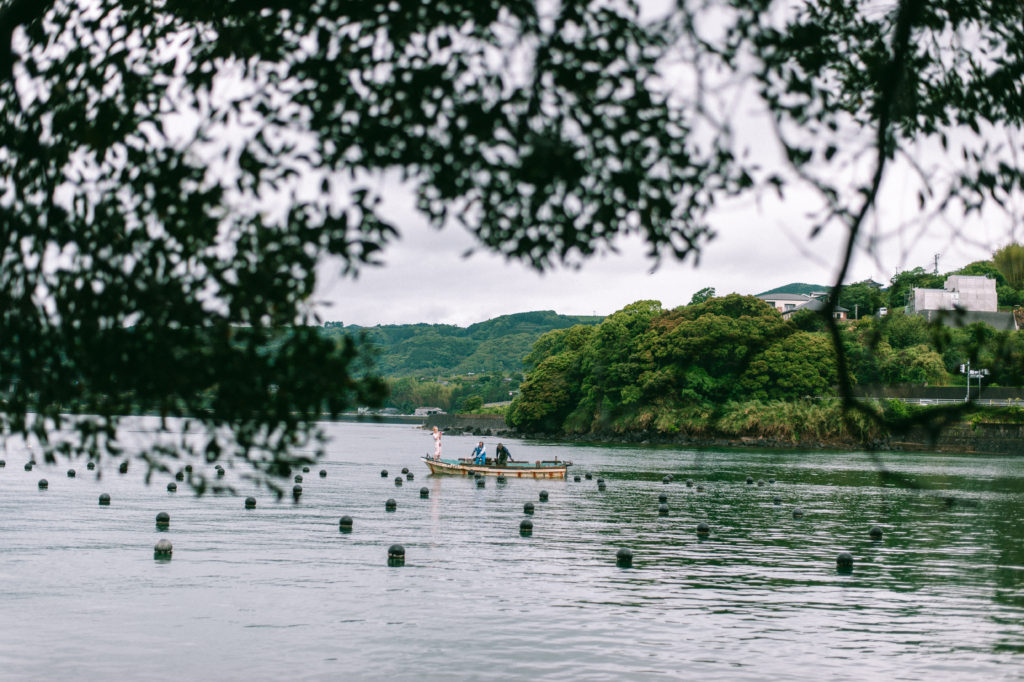
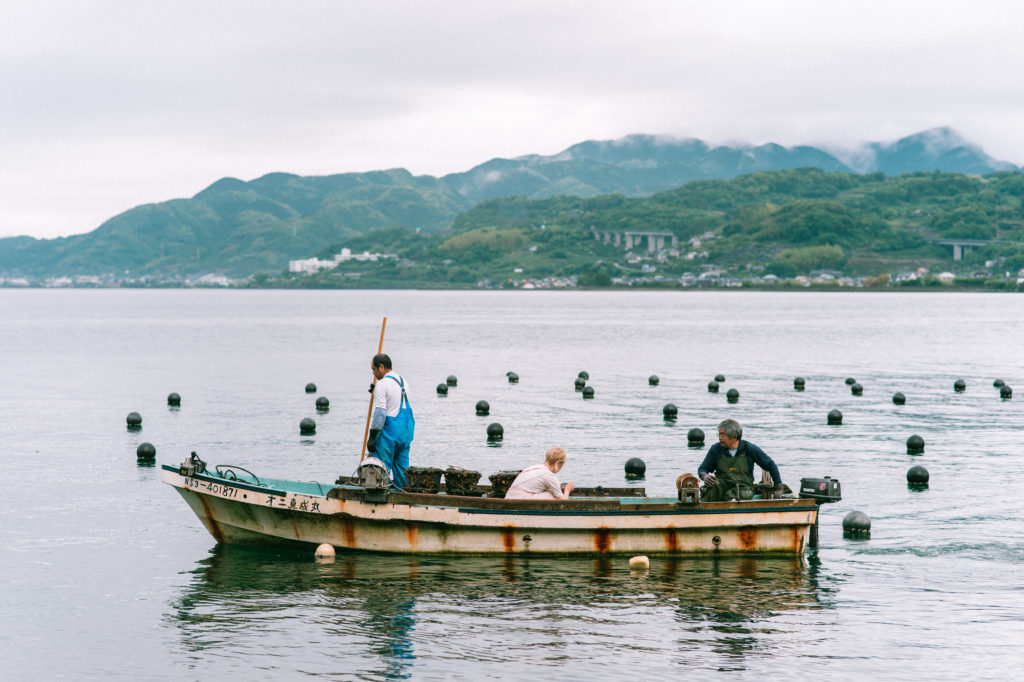
5月中旬過ぎ、海の気温が17度すぎた頃、養殖真珠の珠入れ作業は始まります。
今年は例年よりも梅雨に入るのが早いようです。
珠入れとは、あこや貝の母貝に核を入れることです。その核のまわりにあこや貝が真珠層を作り、真珠が生まれるのです。この作業を挿核手術といいます。まさに、人間に施す手術と同じように、子宮にちいさなメスを入れ、核と細胞をそこにいれます。
珠入れ(挿核手術)下準備を、順番を追って説明します。
What is “Tama- ire”? This involves the insertion of core/nuclei into the Akoya Mother Oysters. Mother oysters make the layer of pearl cells around nuclei. It will cause the layer of the pearl to thicken. Finally, the newly cultivated pearl will come out.
The insertion of nuclear into the womb of Akoya Mother Oyster by scalpel has the same procedure as having Human surgery. It looks so painful for me.
I visited the pearl cultivation farm in the Koto sea.
The rainy season has almost started in the Kyushu region, even though it is only the middle of May. It’s earlier than usual.
Every year, around the middle of May, when the sea temperature becomes 17 degrees Celsius, the distinctive work in the pearl cultivation farm starts. This process is known as “Tama-ire” in Japanese.
The rainy season has almost started in the Kyushu region, even though it is only the middle of May. It’s earlier than usual.
Every year, around the middle of May, when the sea temperature becomes 17 degrees Celsius, the distinctive work in the pearl cultivation farm starts. This process is known as “Tama-ire” in Japanese.
What is “Tama- ire”? This involves the insertion of core/nuclei into the Akoya Mother Oysters. Mother oysters make the layer of pearl cells around nuclei. It will cause the layer of the pearl to thicken. Finally, the newly cultivated pearl will come out.
The insertion of nuclear into the womb of Akoya Mother Oyster by scalpel has the same procedure as having Human surgery. It looks so painful for me.
Let me explain the process of “Tama-ire” further.
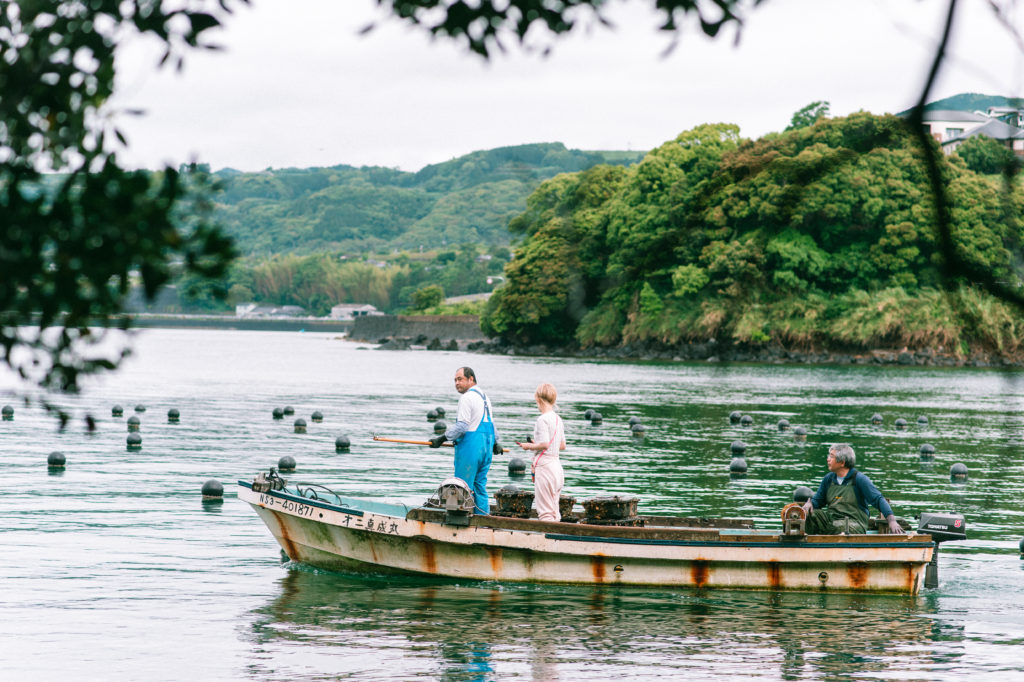
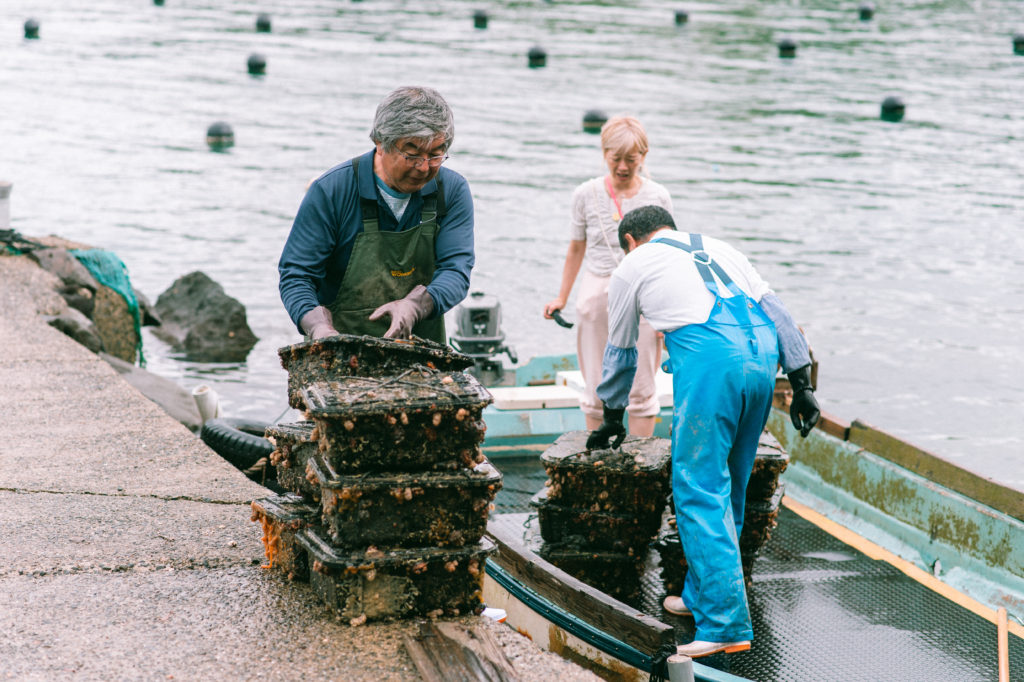
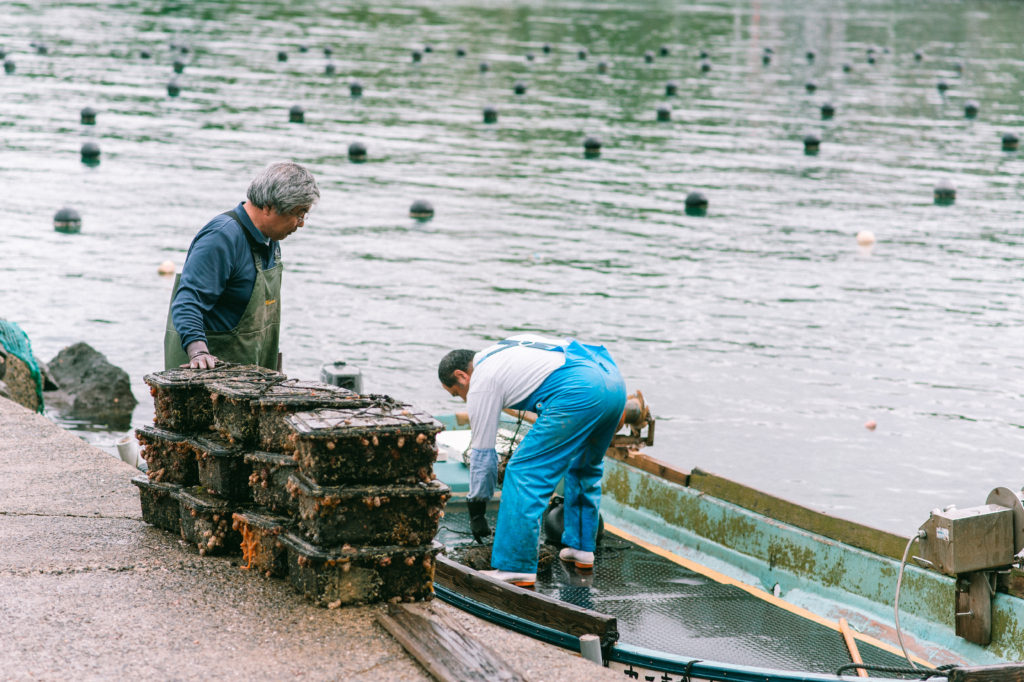
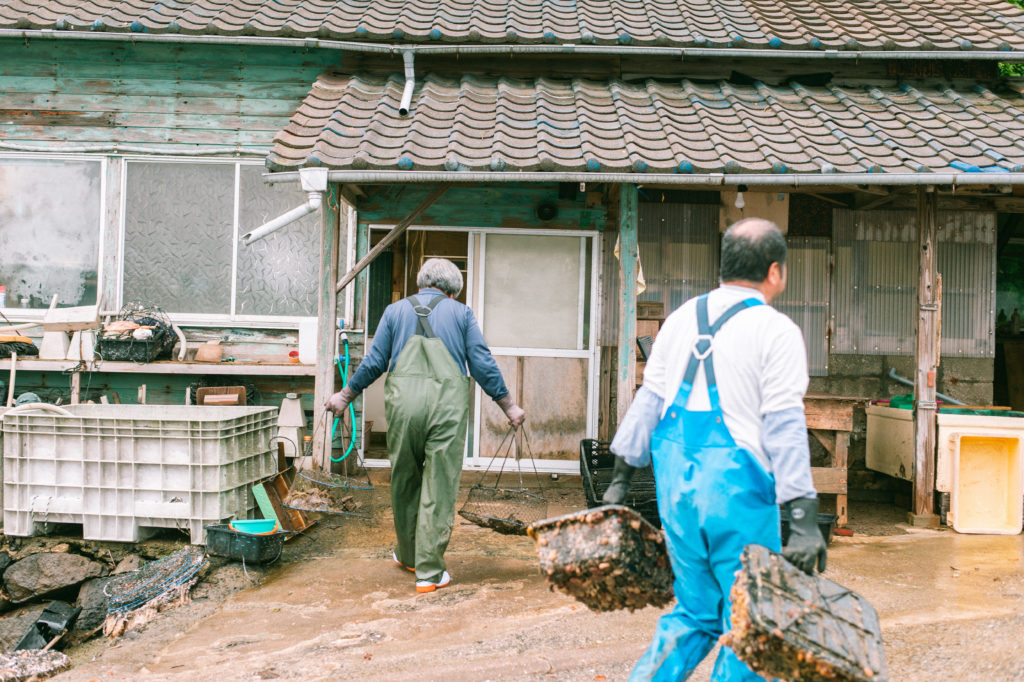
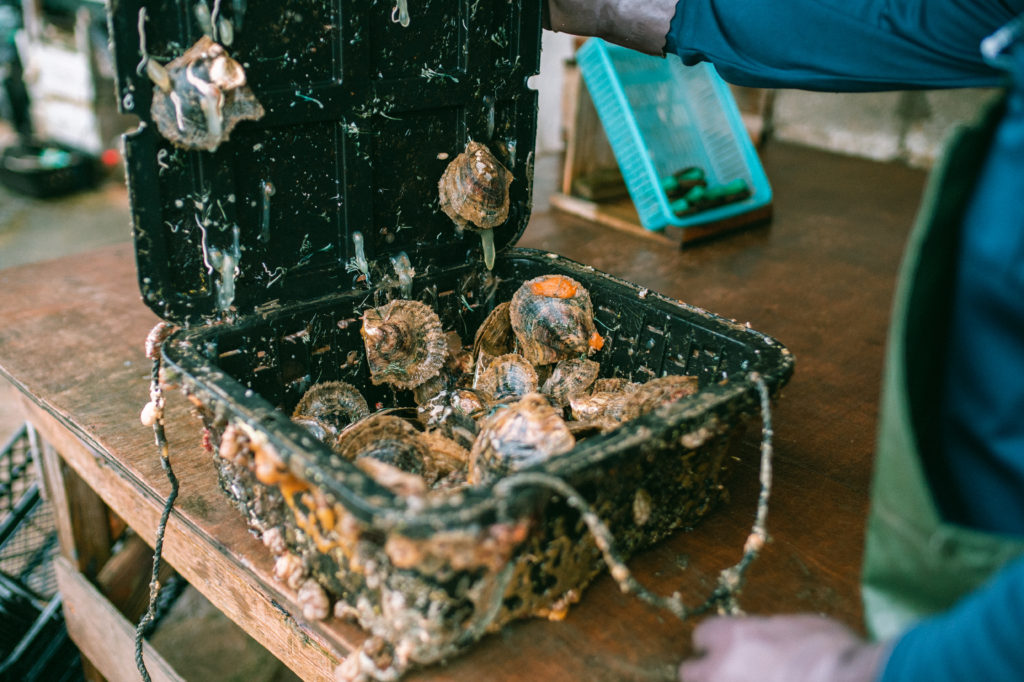
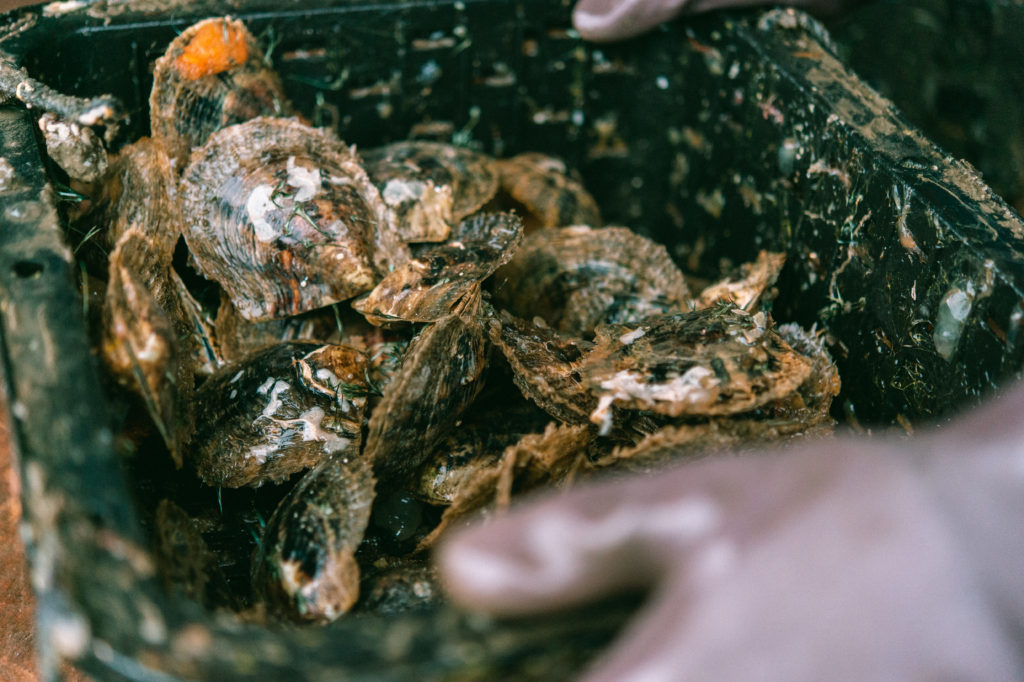
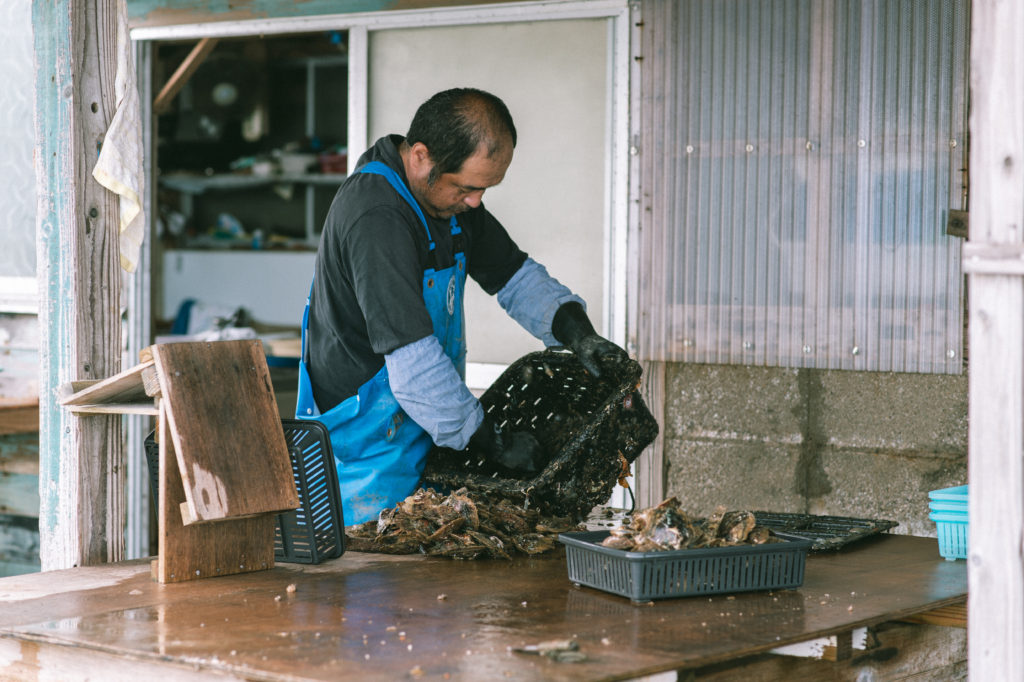
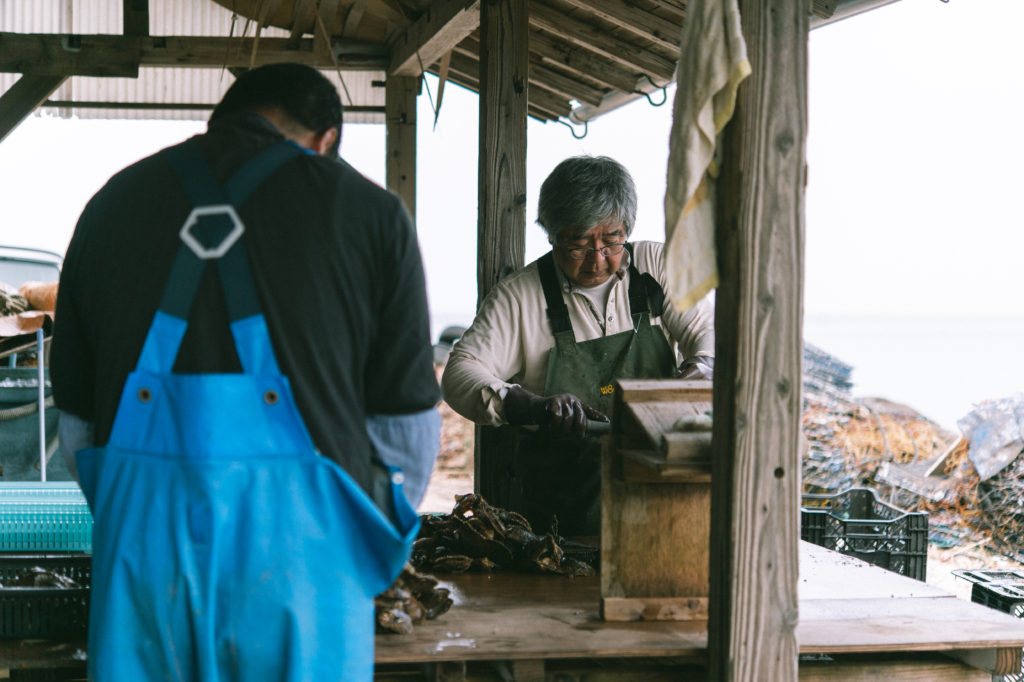
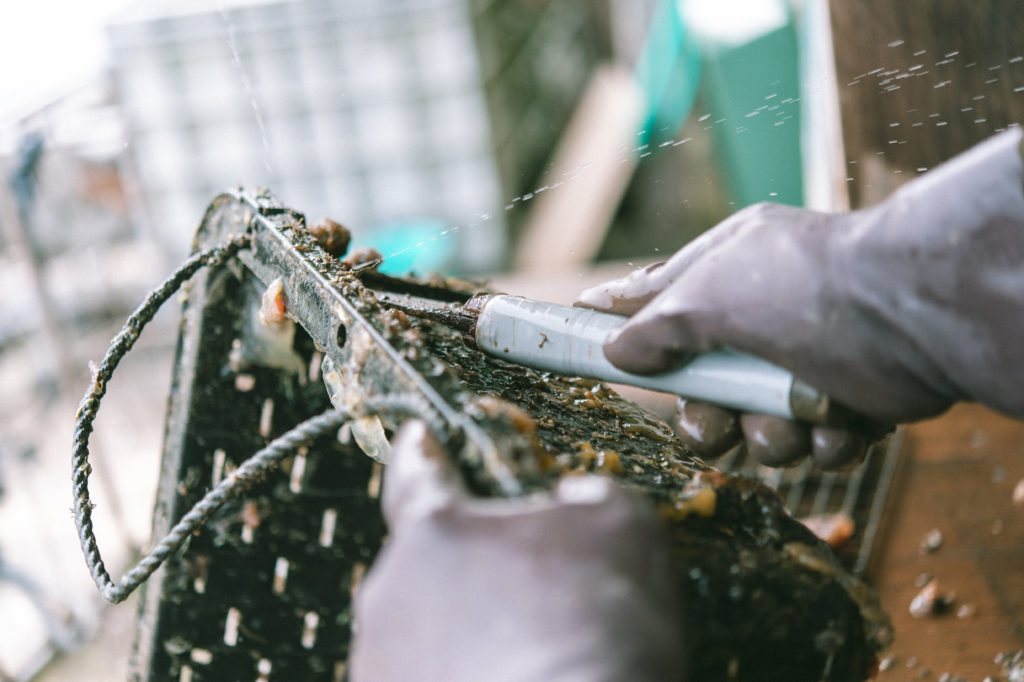
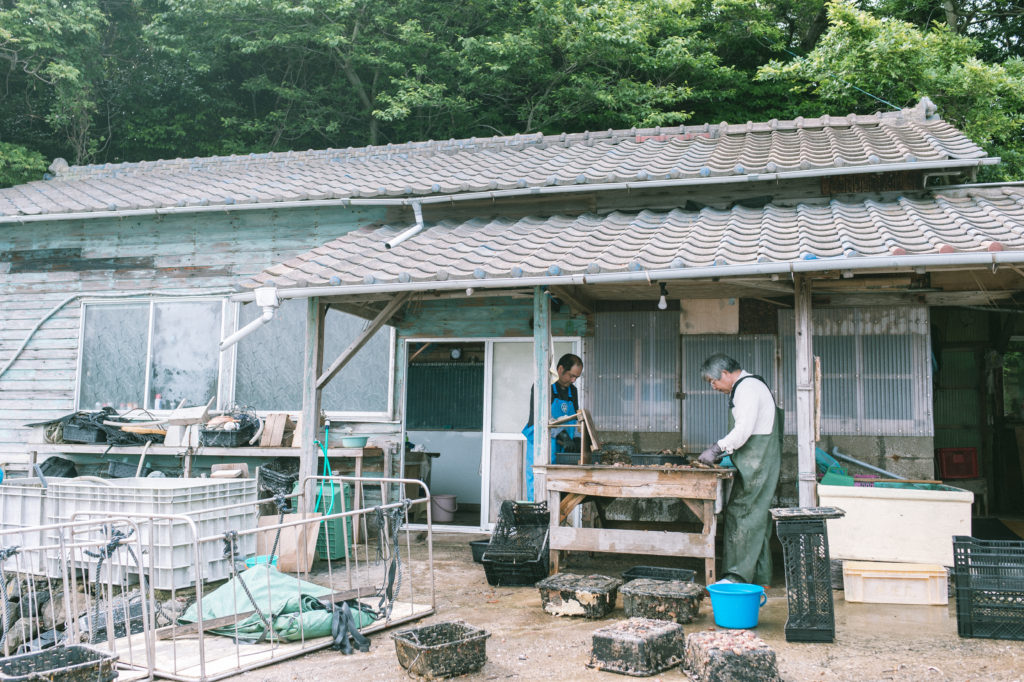
Ⅰ. 珠入れ(挿核手術)下準備
①汚れ落とし
まず、母貝を海からその日作業する分だけとり、ひとつひとつ汚れを落としていきます。
まず、母貝を海からその日作業する分だけとり、ひとつひとつ汚れを落としていきます。
海の中に長く沈んでいるといろんなものが付きます。海は近年状態が良くないため、悪い付着物が多いです。
(珠入れが終わり、母貝を海に戻した後、養殖場の方々は1週間に1回は、様々な付着物を取り除くため、海から引き上げ何万個というあこや貝を洗います。)
I have written all of the preparation processes below before the surgery
(inserting the nuclear into mother oysters).
(inserting the nuclear into mother oysters).
1. Removing the grim
Mother oysters were taken from the sea. The number of mother oysters is based on the worker’s daily capacity to do the surgery.
Then, we remove the grim on the mother oysters one by one. When Akoya oysters have been in the sea for a long time, various things were attached to them. Recently, the sea condition hasn’t been that good and caused a lot of bad accretion.
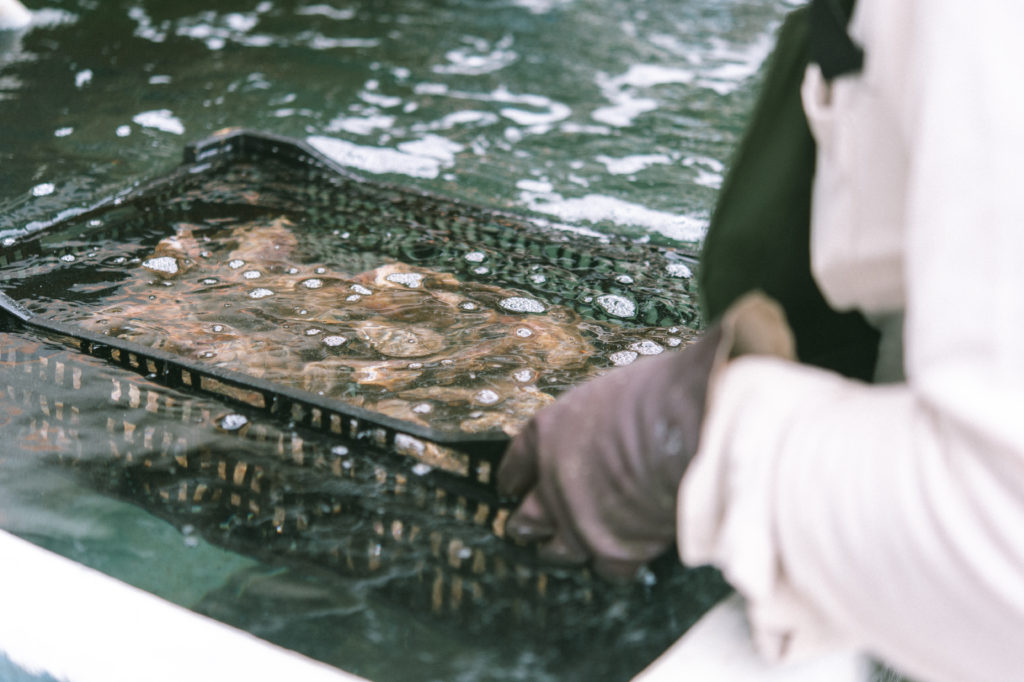
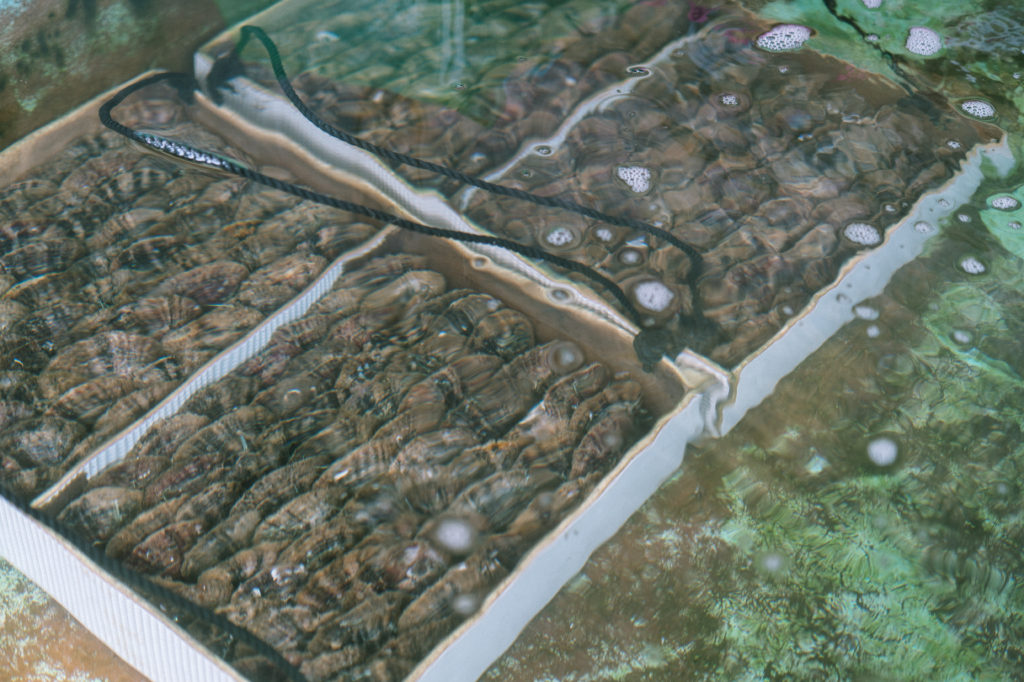
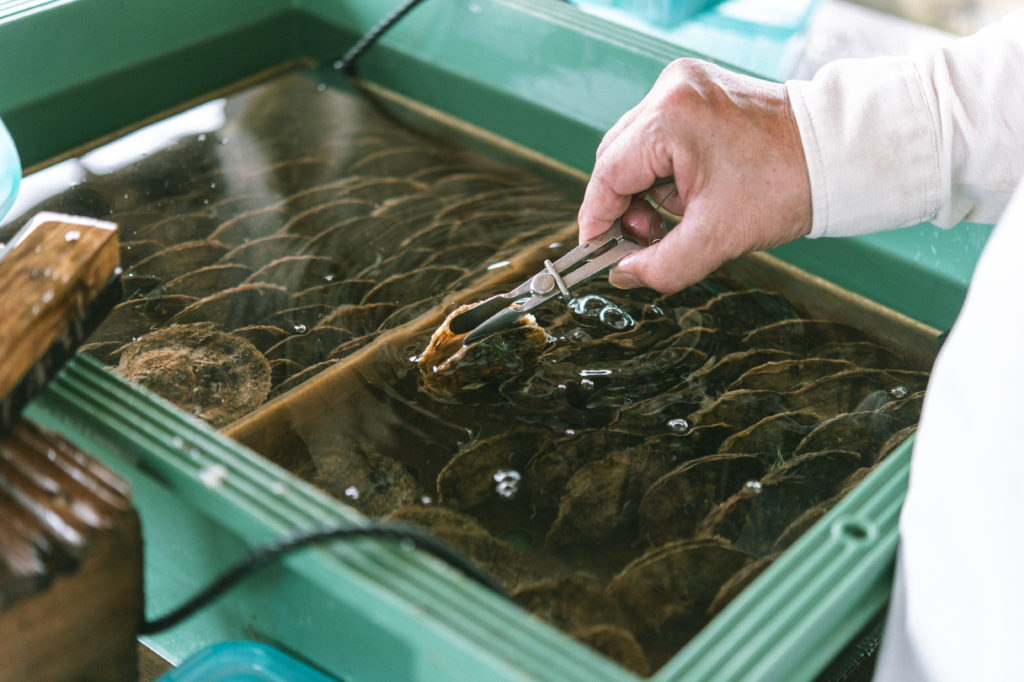
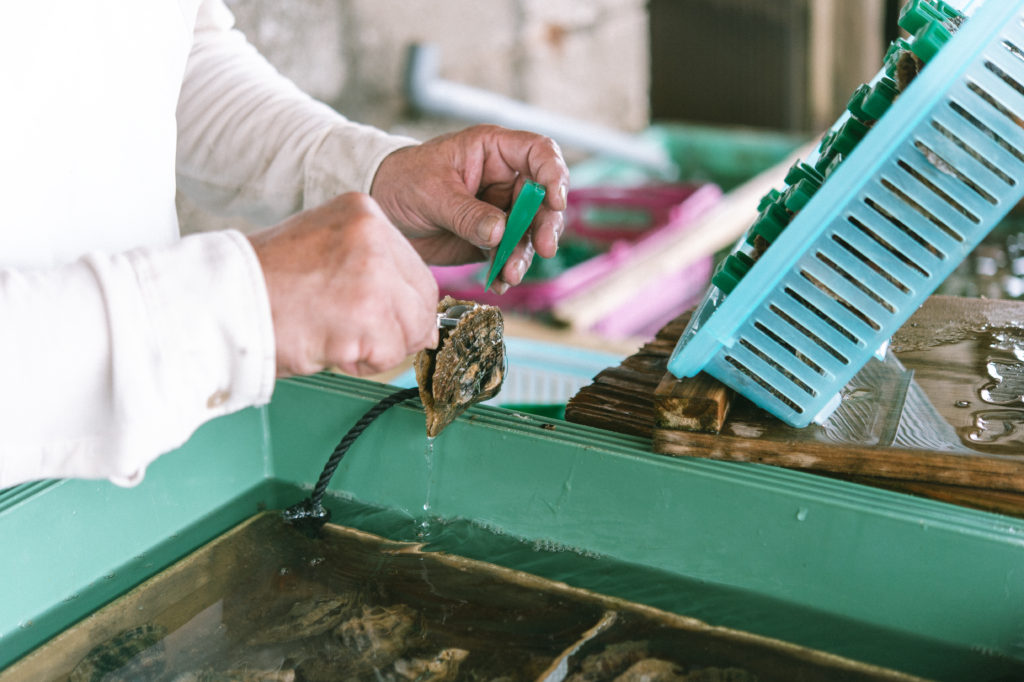
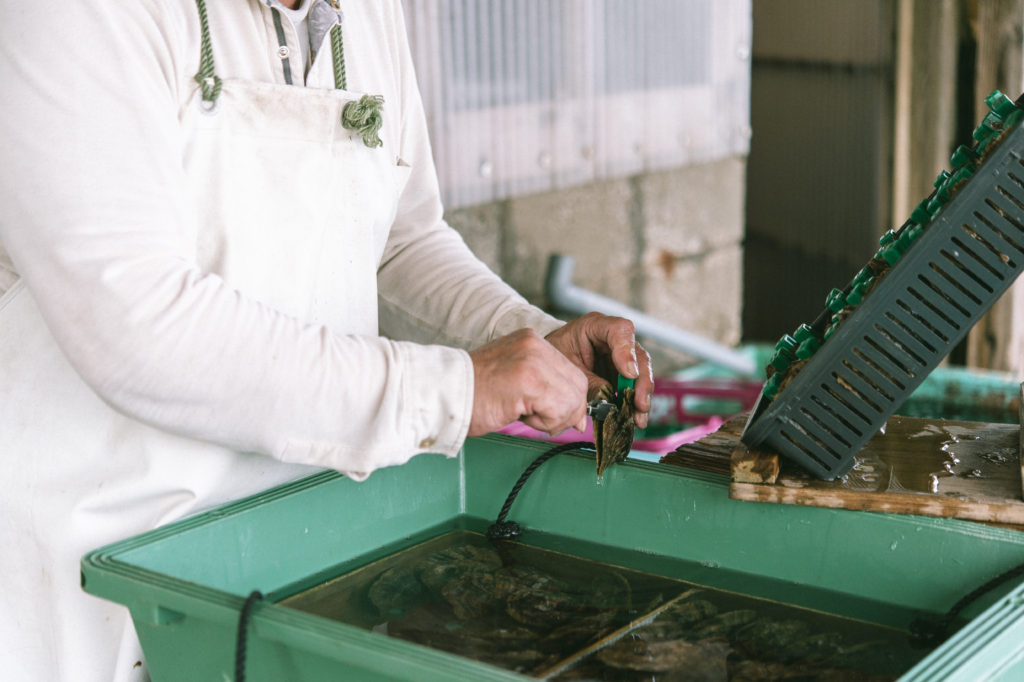
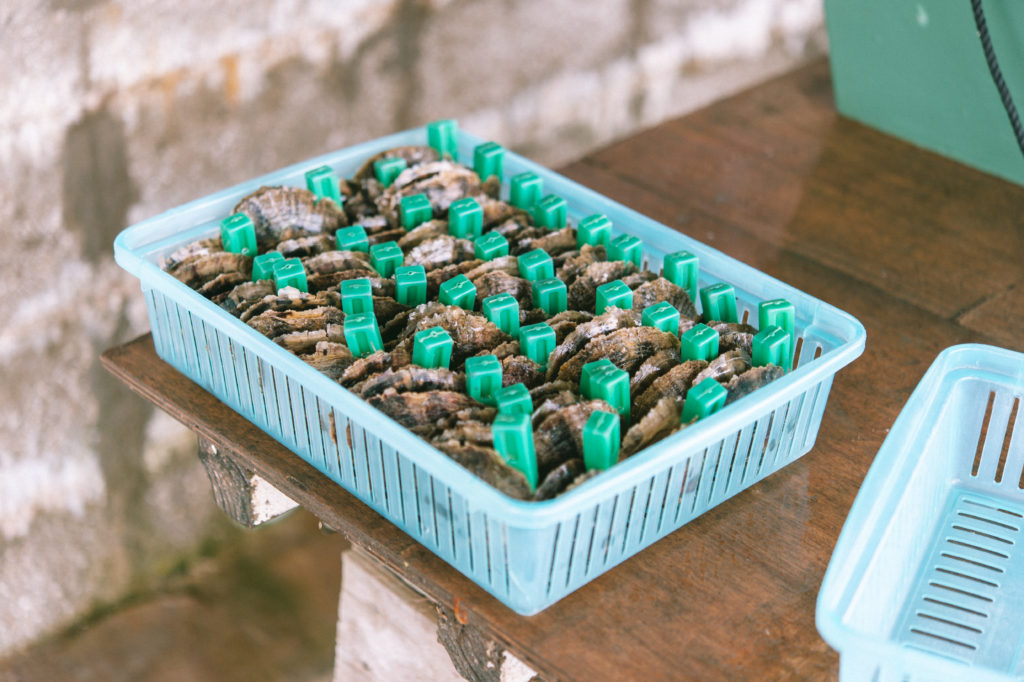
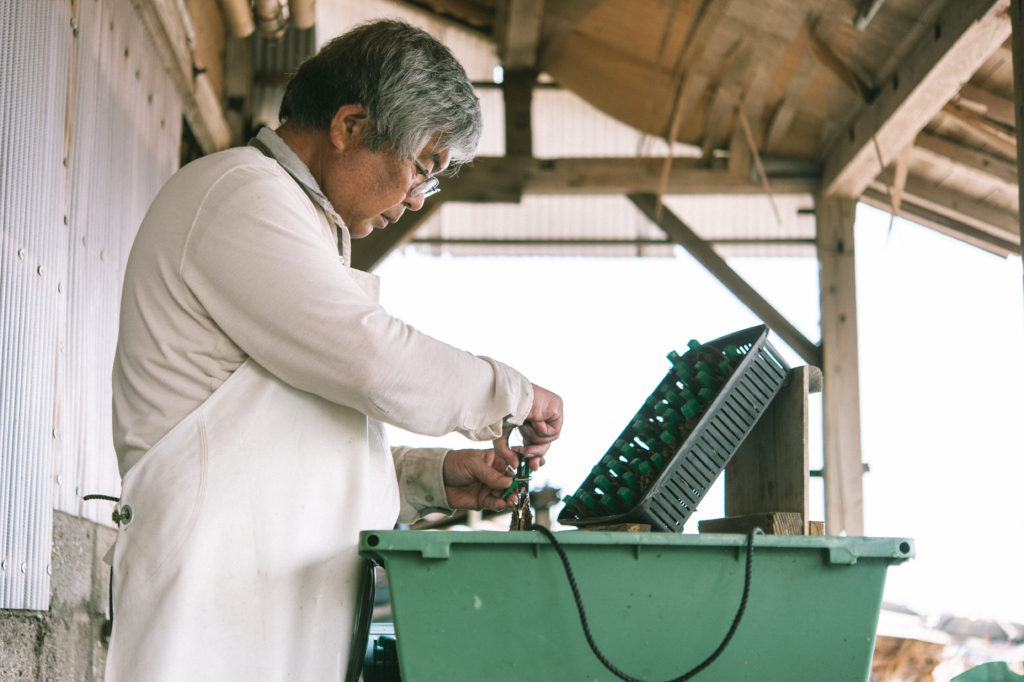
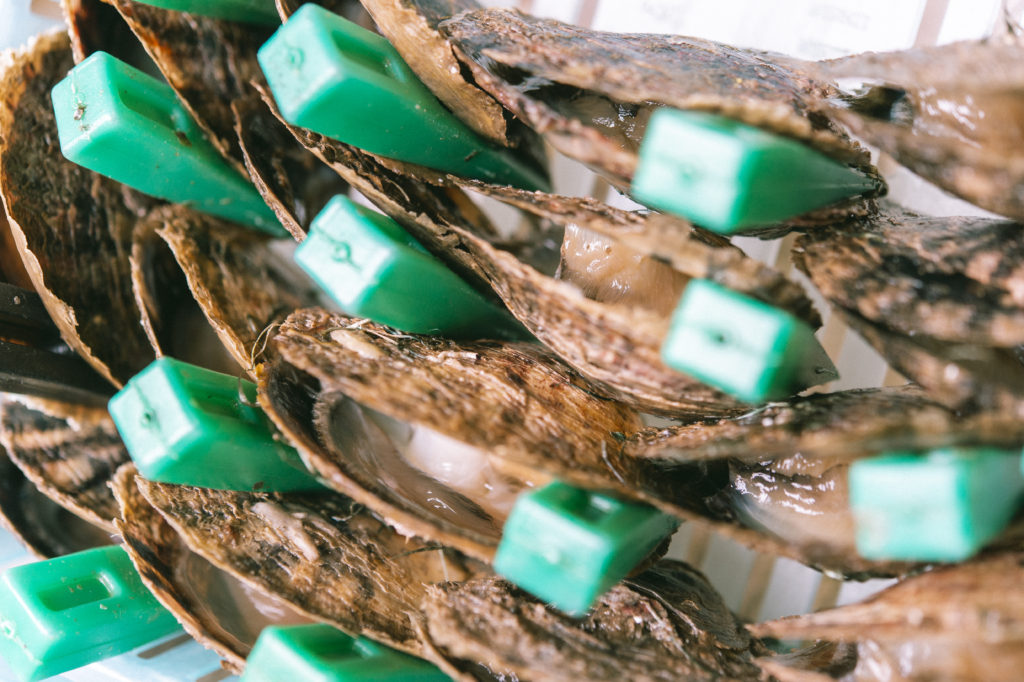
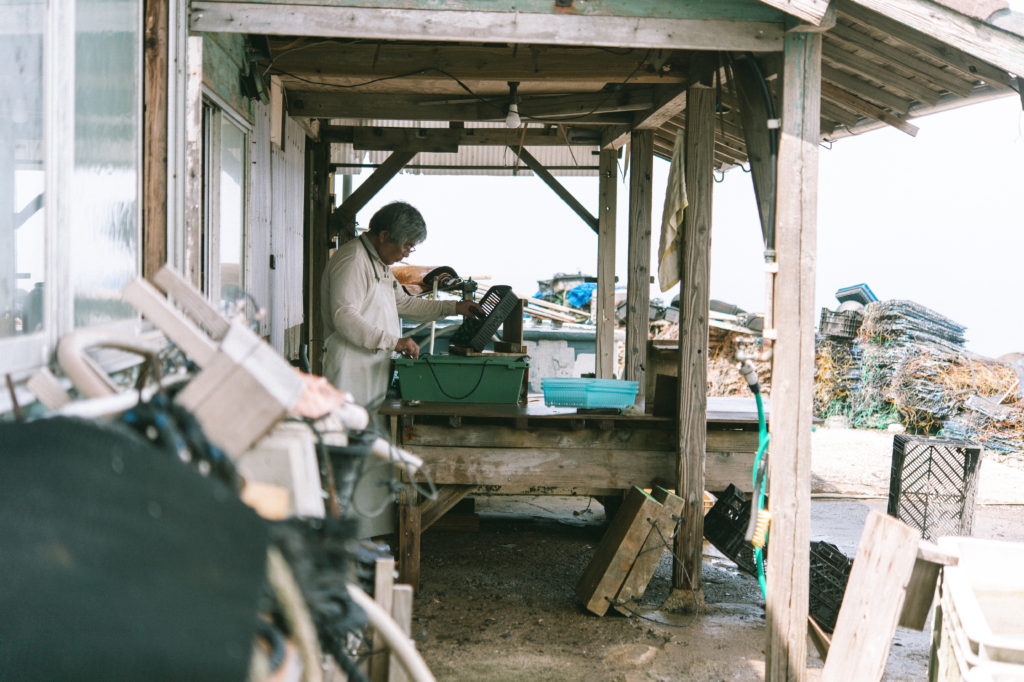
②貝だて
挿核手術のために行う準備です。挿核手術の数時間前に、母貝をすきまなく箱につめ海にいれておきます。この作業を’貝だて’と言います。
母貝の口を自然に開かせるための作業です。あこや貝の口は閉じていて固くなかなか開きません。この口をこじあけると貝を傷つけてしまいます。
こうやって貝を隙間なく詰めておくことで貝は息ができず苦しくなります。手術近くに、ひとつの貝を抜き取ると、隙間ができ、貝たちが一斉に呼吸し始めます。
③栓さし
この貝たちが口をあけたときに、口を閉じてしまわないように、ひとつひとつ貝の口にくさび型の木栓を閉まらないように挟み込む作業を栓さしと言います。
2.Kai-date (Placing the oysters in an Upright position)
This is the former work for inserting nuclear into Akoya mother oysters.
Before the surgery (inserting core into the oysters), they should be tightly arranged in the box and put it into the sea. This operation is called “Kai-date”.
Kai-date is the process to open mother akoya’s mouth naturally.
Naturally, Akoya mother oysters mouth is closed tightly and it’s very difficult to open.
If we would force to open it, it can get some damages. Because they are tightly arranged in the box in the sea, it will be difficult for them to breathe.
If we would force to open it, it can get some damages. Because they are tightly arranged in the box in the sea, it will be difficult for them to breathe.
Once one mother was pulled out from the box, the remaining oyster will open their mouth to breathe. Thus, this is a good and natural way of opening their mouth without hurting them.
3. Sen-sashi (Putting a stopper on mother oyster’s mouth)
To avoid them from closing their mouthes again, stoppers will be put on their mouthes. This process is called “Sen-sashi”. Farmers will put a stopper on the mouth of the mother oysters one by one.
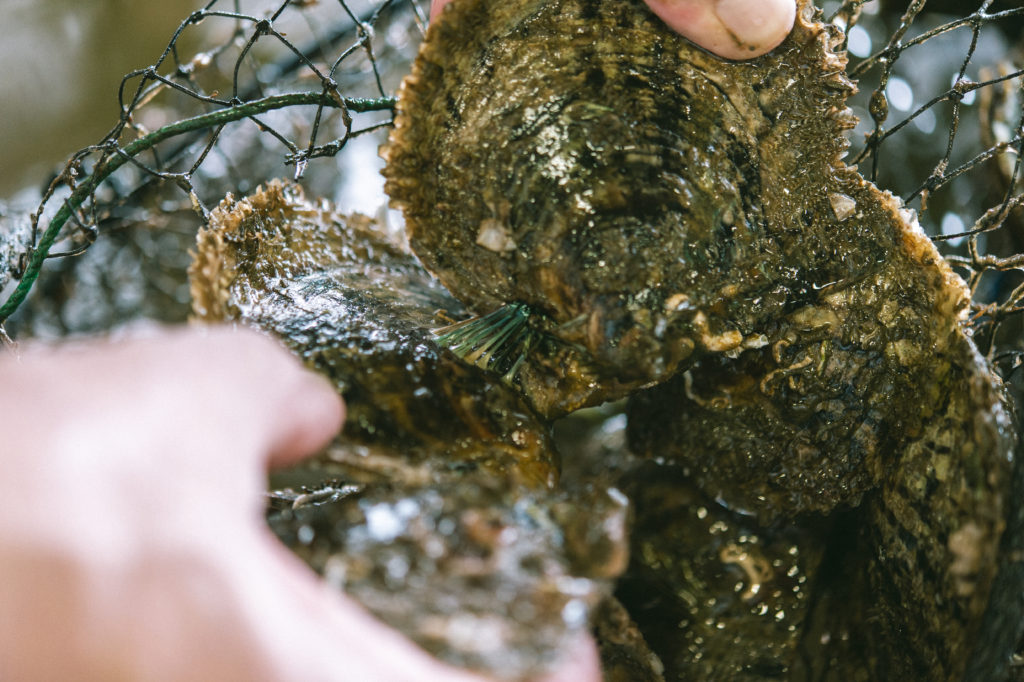
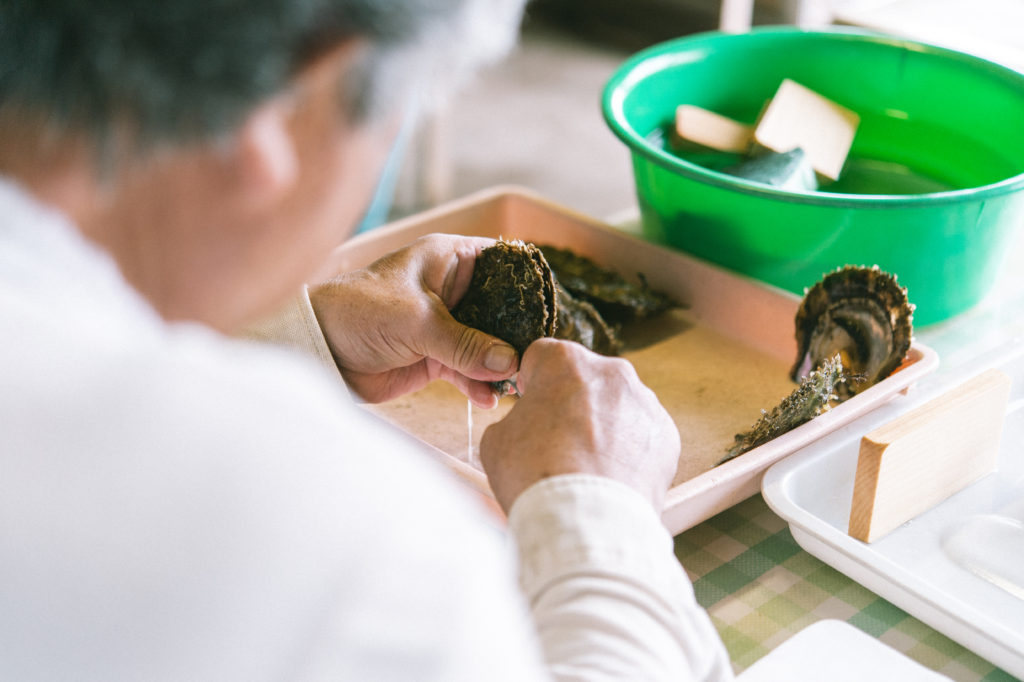
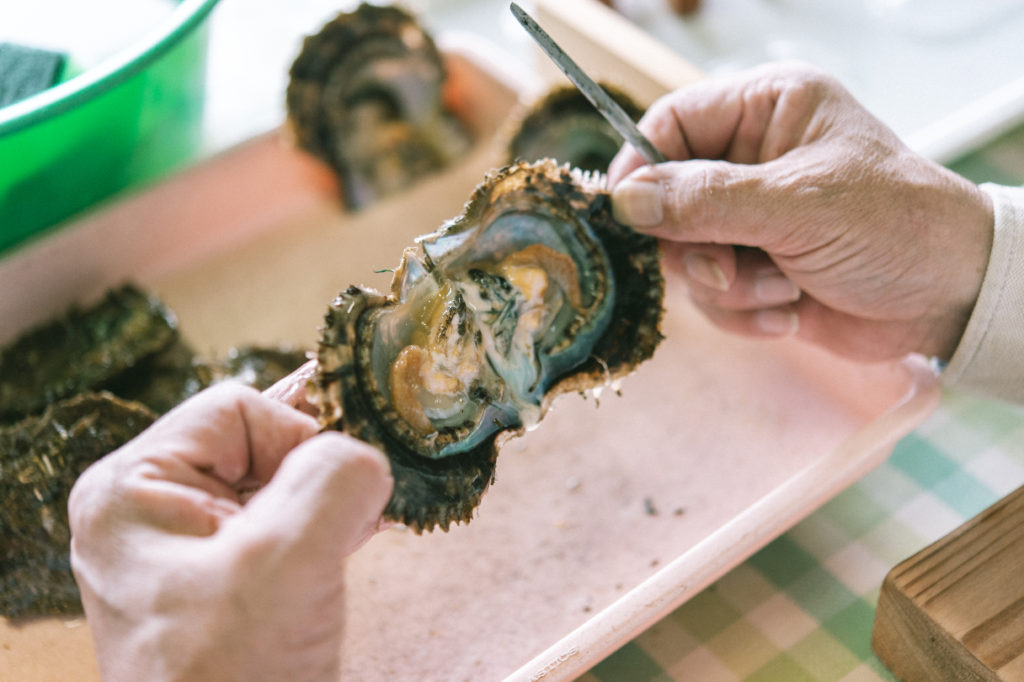
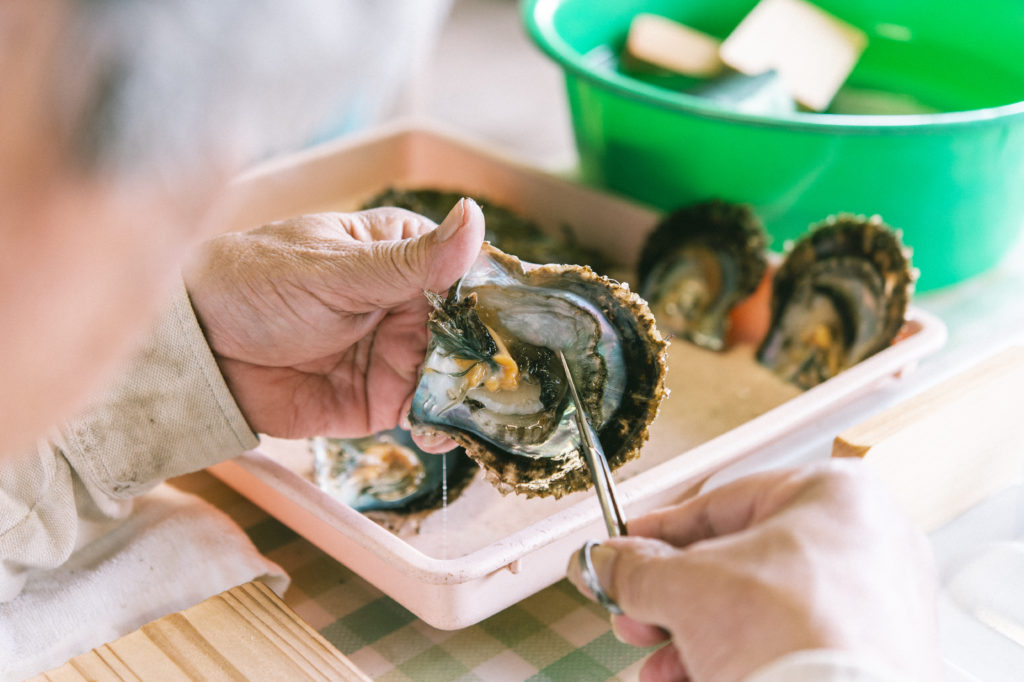
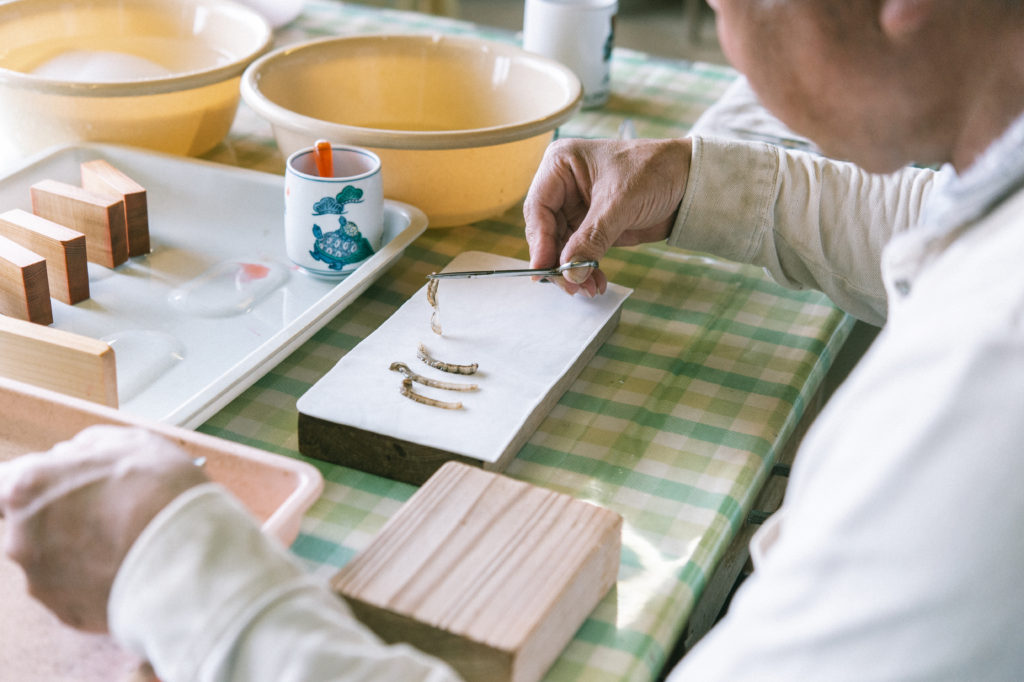
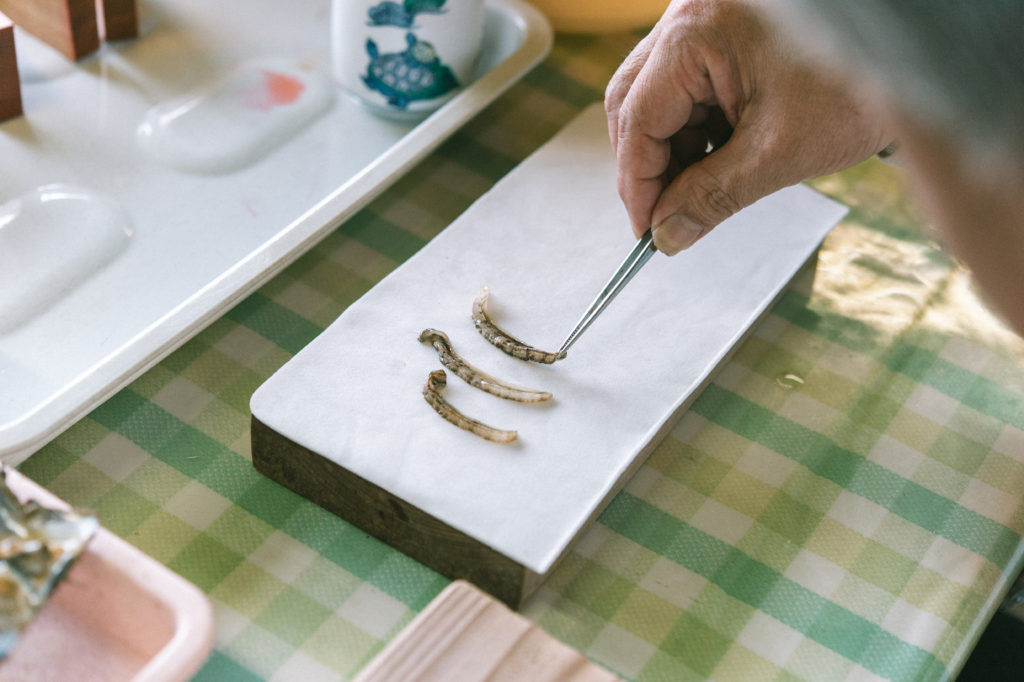
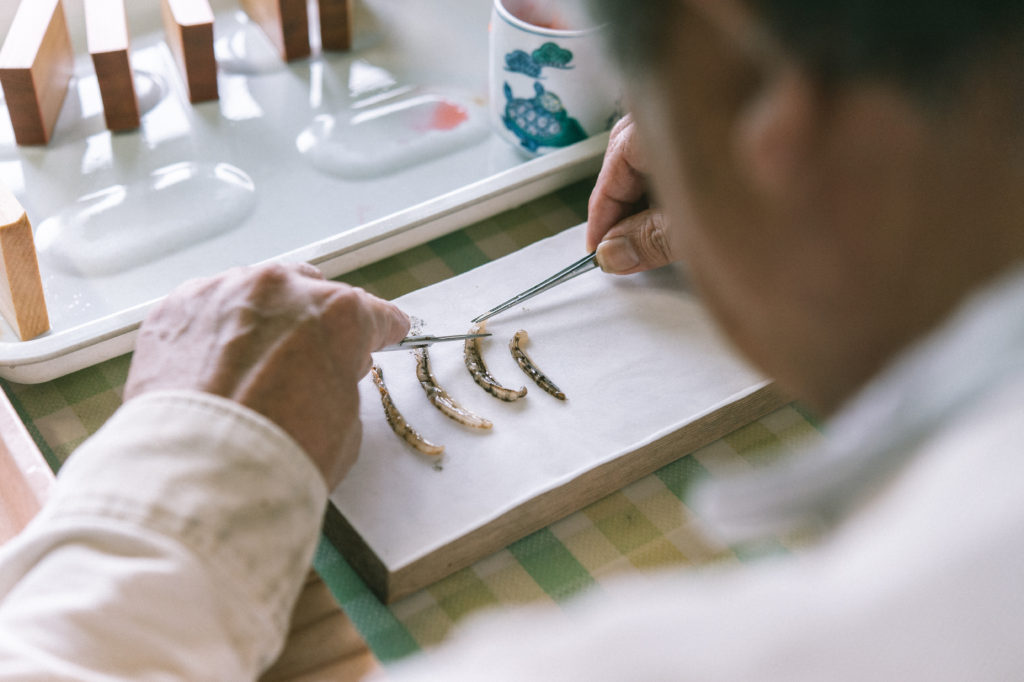
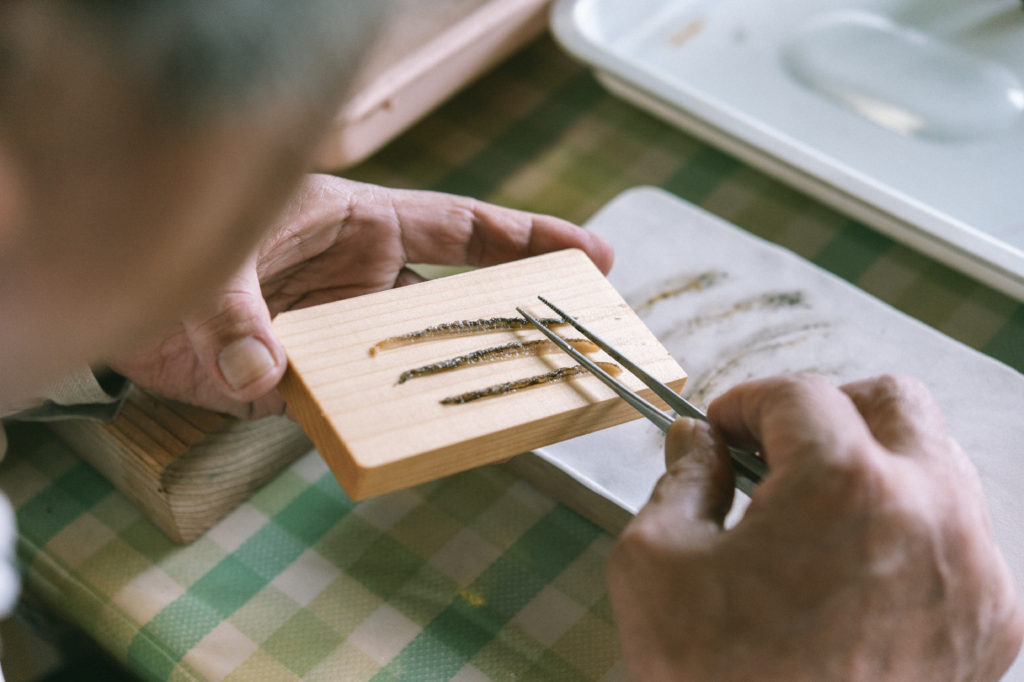
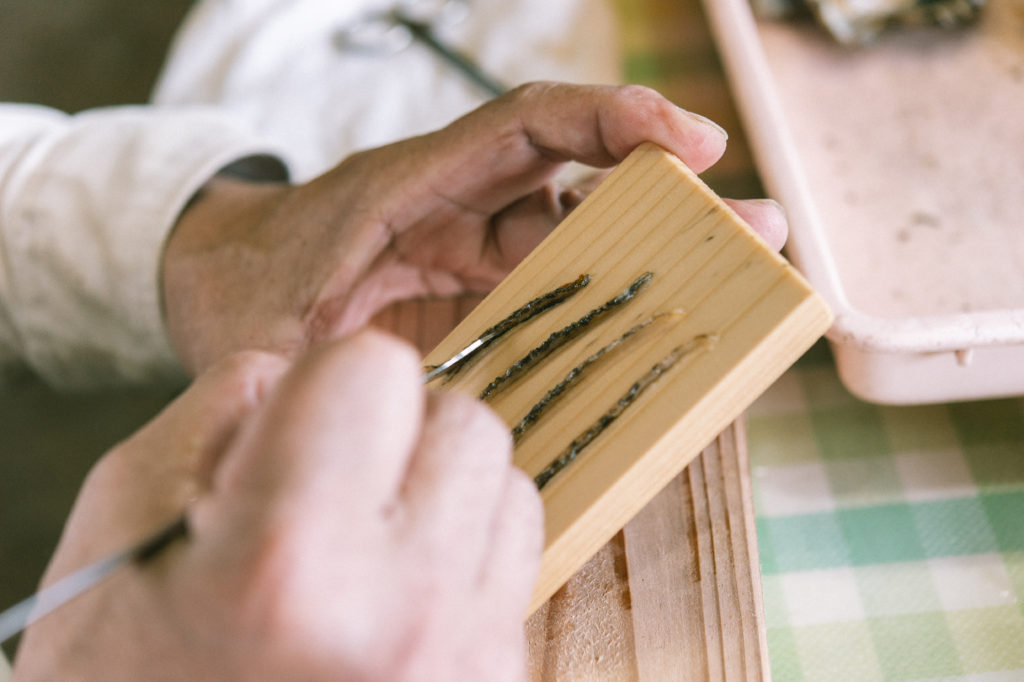
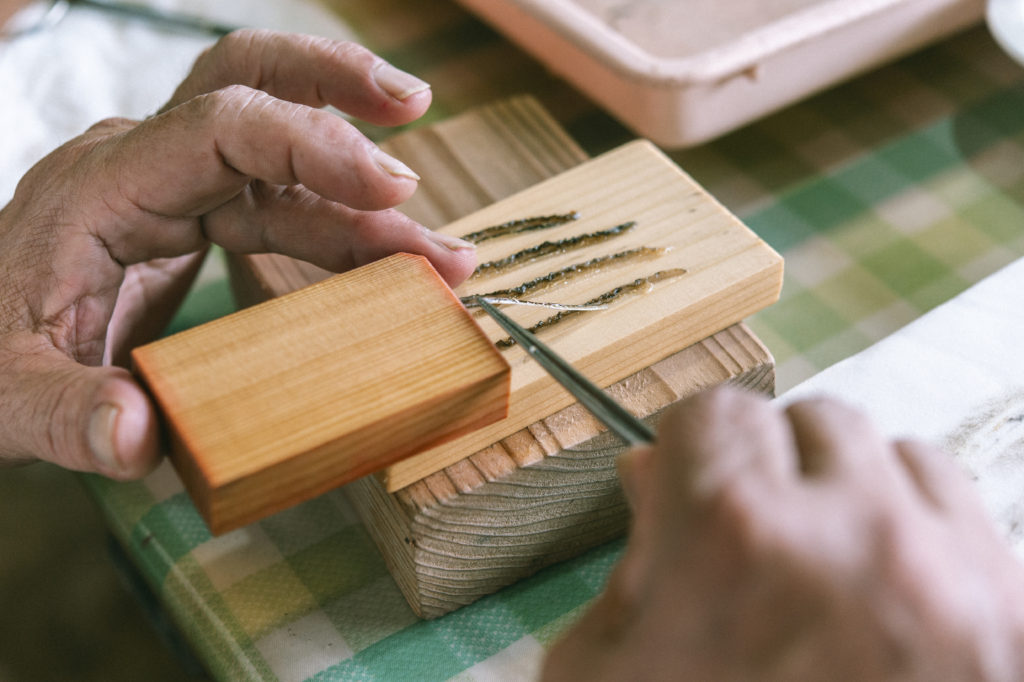
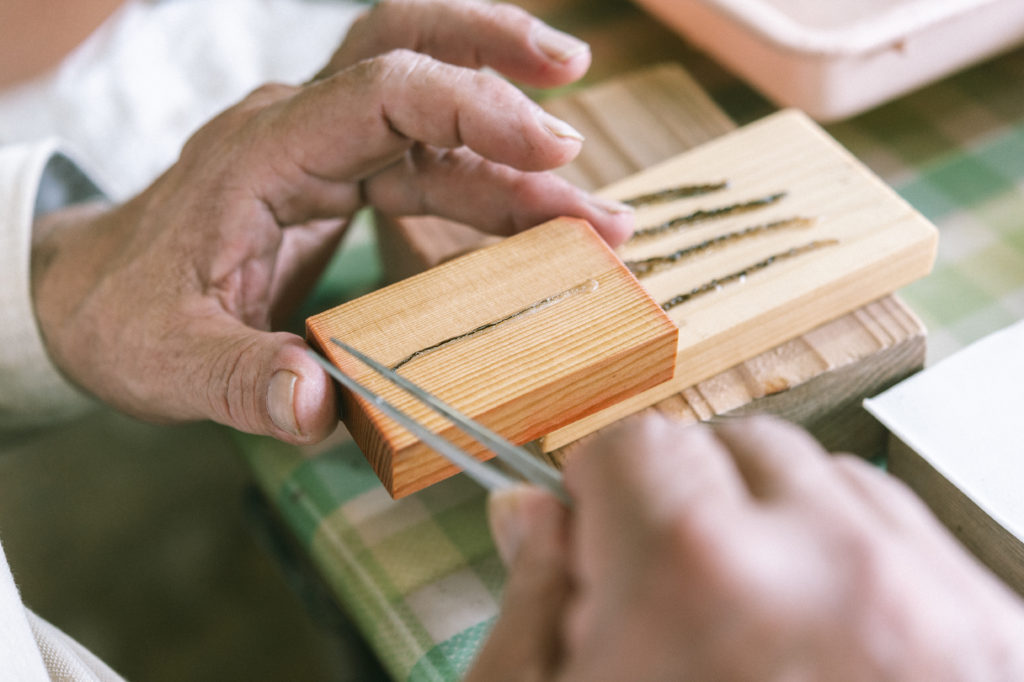
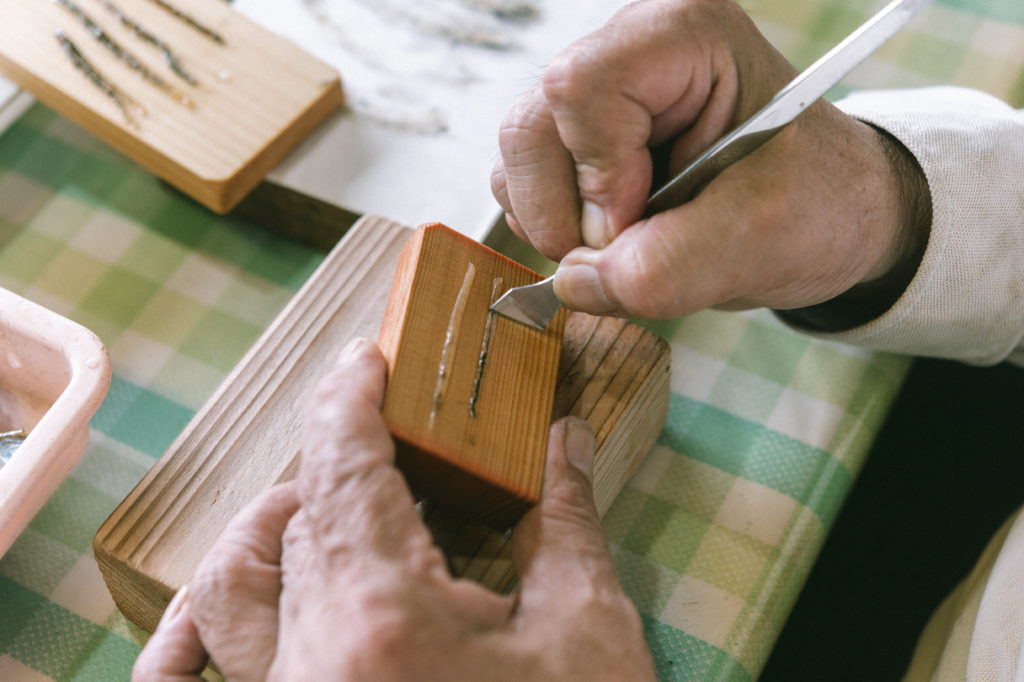
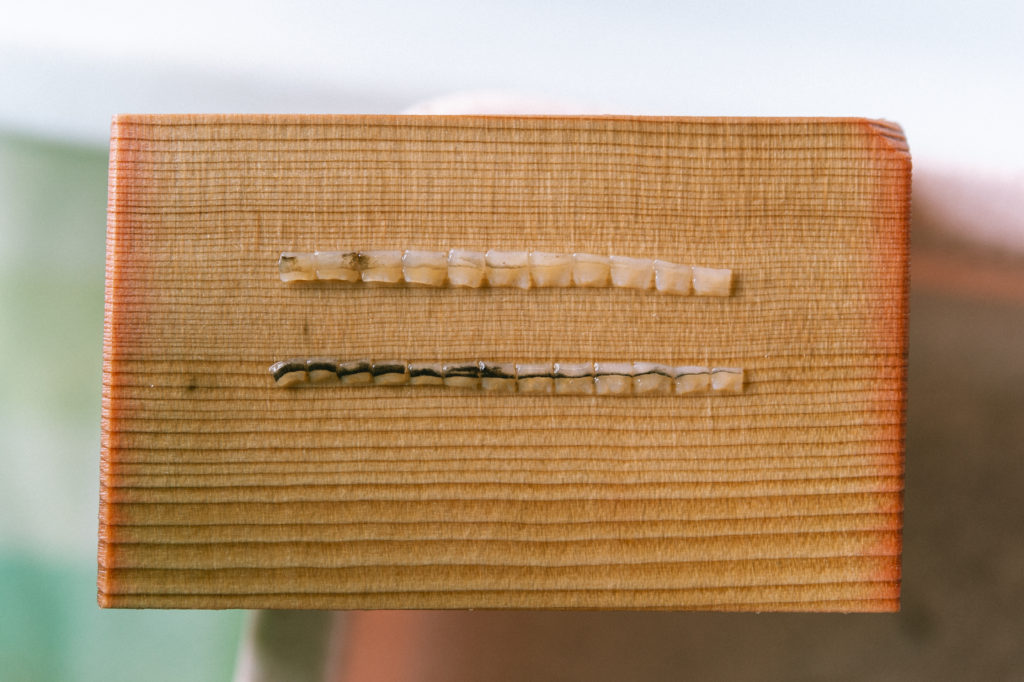
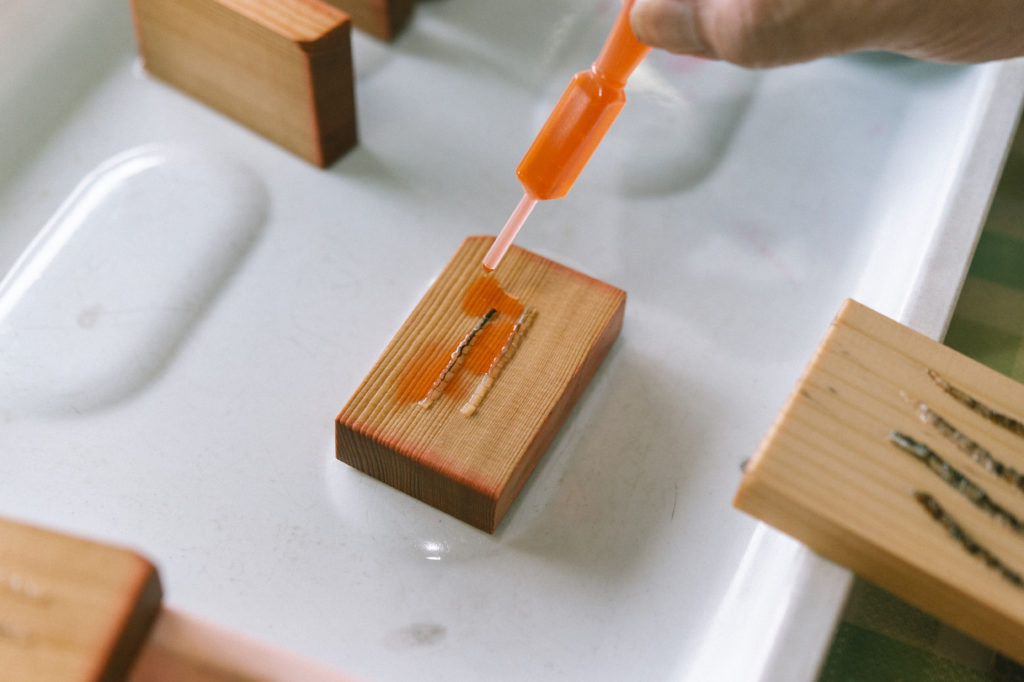

上記の写真について
●ピース貝:真珠の色は貝の内側の色と同じ色です。つまり美しい色の真珠を生み出すために、貝の内側が綺麗な色の貝を選び、その細胞(ピース)が使われます。
これをピース貝と言います。
About photos above
●Piece oyster: The surface of the pearl has the same material as the inner surface of the Akoya shell, which is known as “the mother of pearl”.To produce the beautiful color of pearls, we will choose the oysters that have the beauty of the mother of pearl.
From this system, cells, known as “piece”, is taken from the inside of Akoya pearl, which has the beauty of the mother of pearl. We call this Akoya oyster, a “Piece oyster”.
Ⅱ.
ここから挿核手術、珠入れの順番説明をします。
まず最初にあこや真珠を作るには二つの種類のあこや貝が必要です。
ここから挿核手術、珠入れの順番説明をします。
まず最初にあこや真珠を作るには二つの種類のあこや貝が必要です。
●ピース貝:真珠の色は貝の内側の色と同じ色です。つまり美しい色の真珠を生み出すために、貝の内側が綺麗な色の貝を選び、その細胞(ピース)が使われます。
これをピース貝と言います。
これをピース貝と言います。
●母貝:このピースと呼ばれる細胞と核をお母さん貝の子宮にいれて、育てることによりあこや真珠が生まれます。まさに育てる貝なので母貝と呼ばれます。
琴の海は、この母貝となる貝が豊富だった、つまり太古の昔から栄養の良い海で健康なあこや貝が育っていたということです。
この二つのあこや貝から一つのあこや真珠が誕生します。
つまり、二つの命がひとつの真珠を生み出すのに必要です。
つまり、二つの命がひとつの真珠を生み出すのに必要です。
II
The process of surgery (inserting nuclear into the mother oyster)
First, we need two types of Akoya oysters to produce an Akoya pearl.
The process of surgery (inserting nuclear into the mother oyster)
First, we need two types of Akoya oysters to produce an Akoya pearl.
●Piece oyster: The surface of the pearl has the same material as the inner surface of the Akoya shell, which is known as “the mother of pearl”.
To produce the beautiful color of pearls, we will choose the oysters that have the beauty of the mother of pearl.
From this system, cells, known as “piece”, is taken from the inside of Akoya pearl, which has the beauty of the mother of pearl. We call this Akoya oyster, a “Piece oyster”.
To produce the beautiful color of pearls, we will choose the oysters that have the beauty of the mother of pearl.
From this system, cells, known as “piece”, is taken from the inside of Akoya pearl, which has the beauty of the mother of pearl. We call this Akoya oyster, a “Piece oyster”.
● Mother oyster: The mother oyster, which produces pearls from its womb. How to produce pearls by mother oysters?
First, we put the cell, called “a piece”, and a nuclear into the mother oyster’s womb. Then, the “piece” starts creating a sac that covers the nuclear.
First, we put the cell, called “a piece”, and a nuclear into the mother oyster’s womb. Then, the “piece” starts creating a sac that covers the nuclear.
After that, the same material of mother of pearl will be produced in it.
The Koto Sea used to have lots of mother oysters. This means that it was a rich sea from the ancient times where healthy acoya oysters lived.
The Koto Sea used to have lots of mother oysters. This means that it was a rich sea from the ancient times where healthy acoya oysters lived.
Therefore, the lives of two oysters are essential to the birth of the beautiful Akoya Pearls.
They need to sacrifice their own lives for the sake of the creation of another beauty.
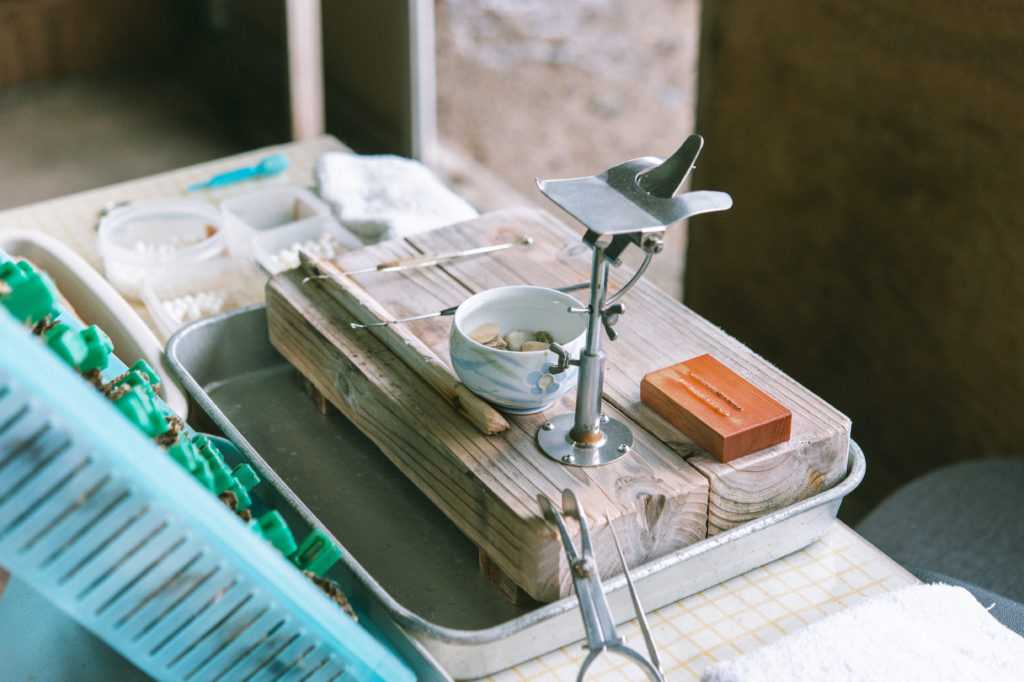
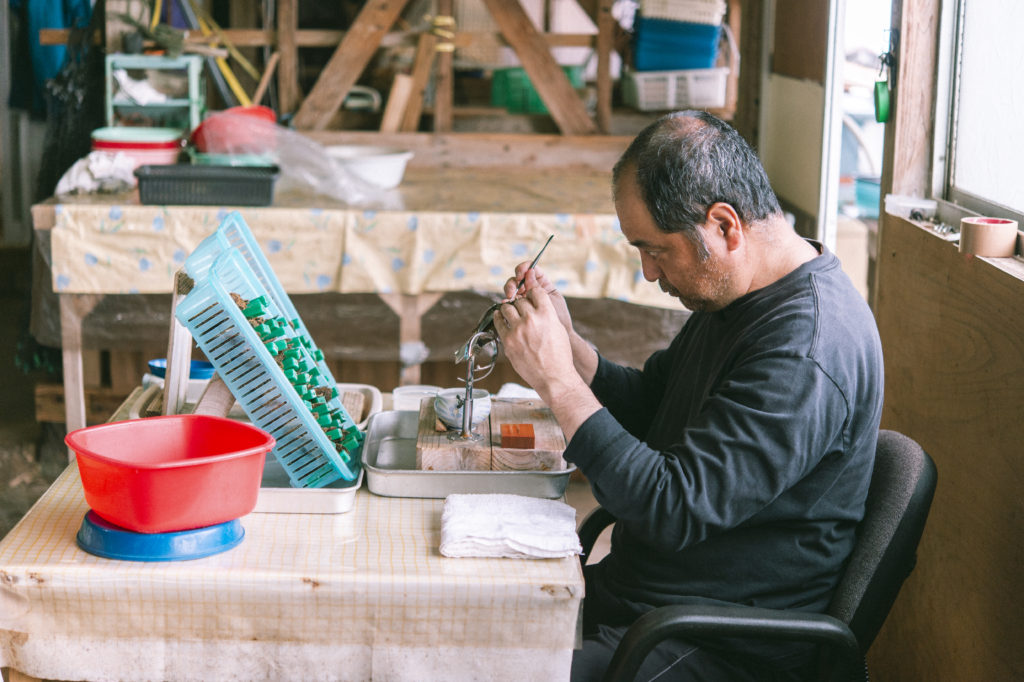
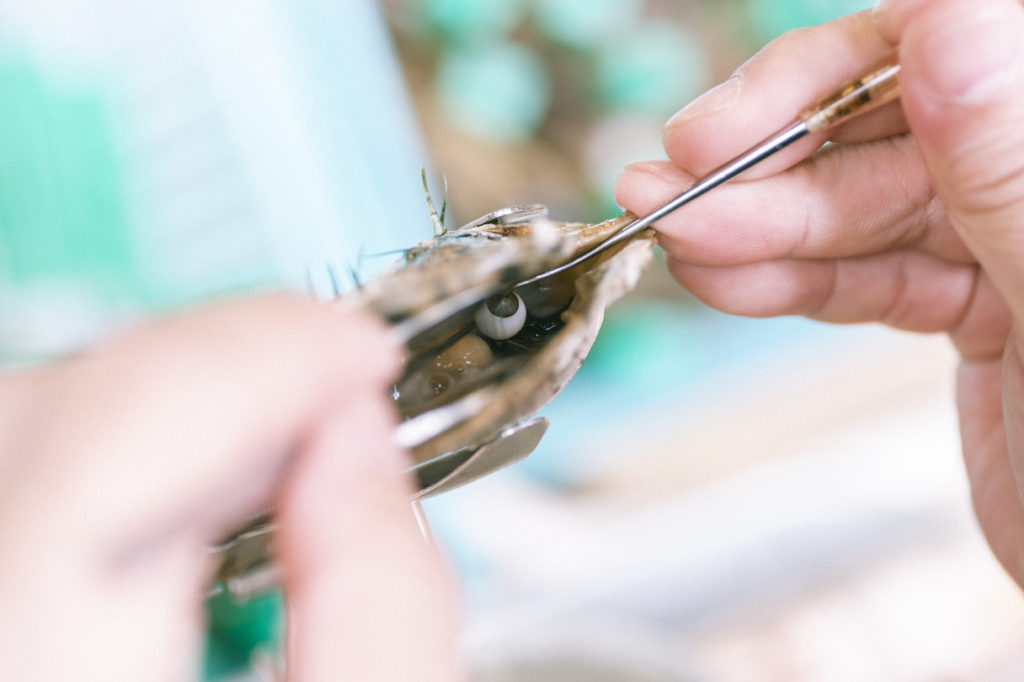
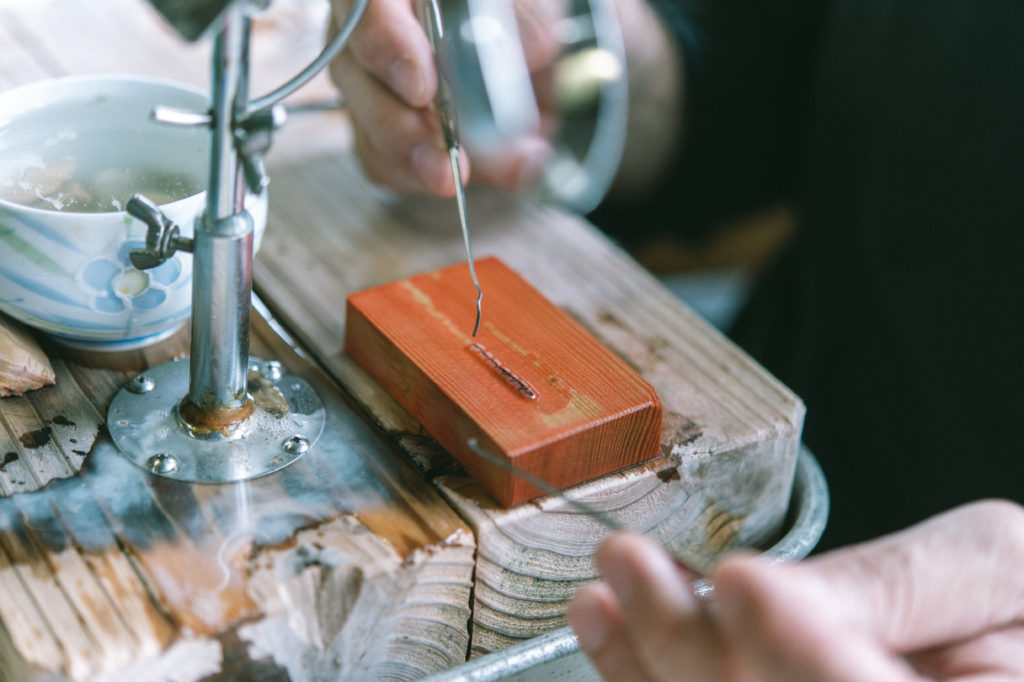
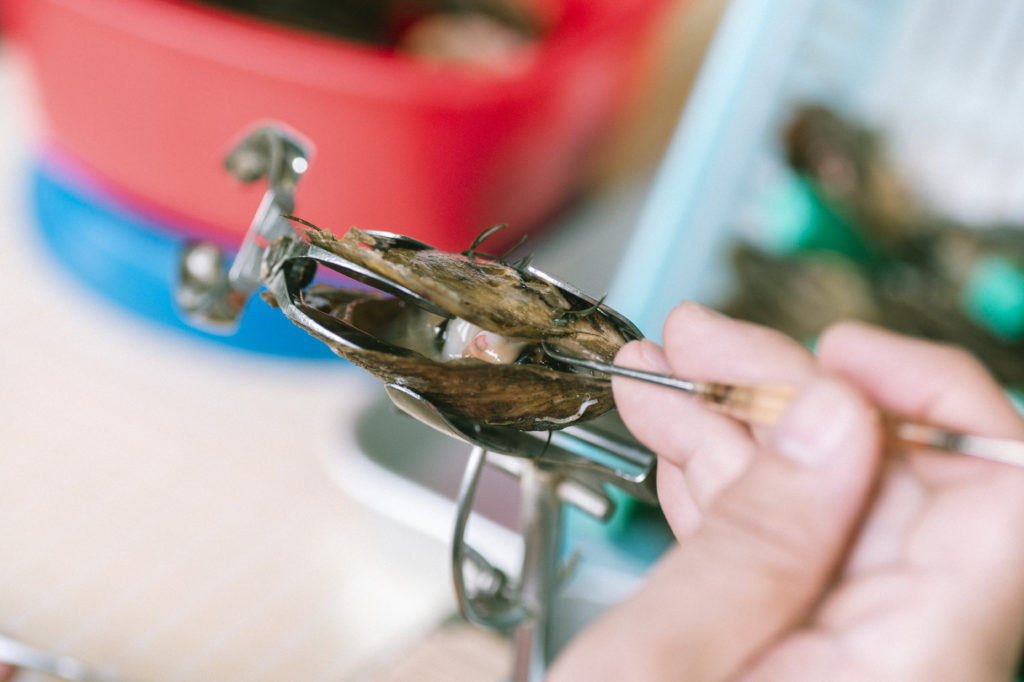
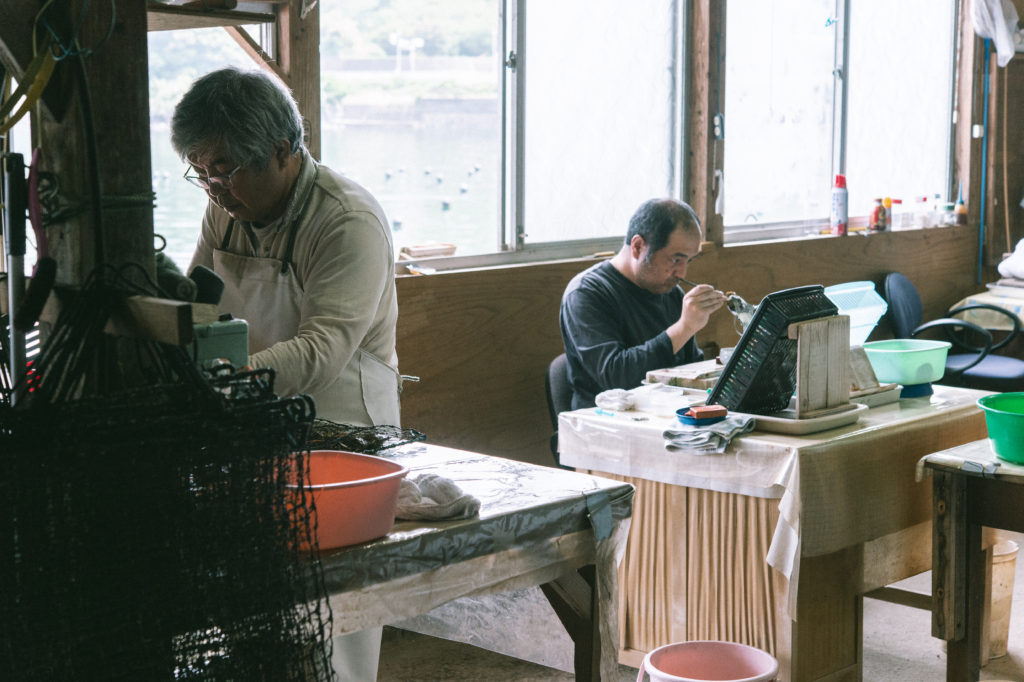
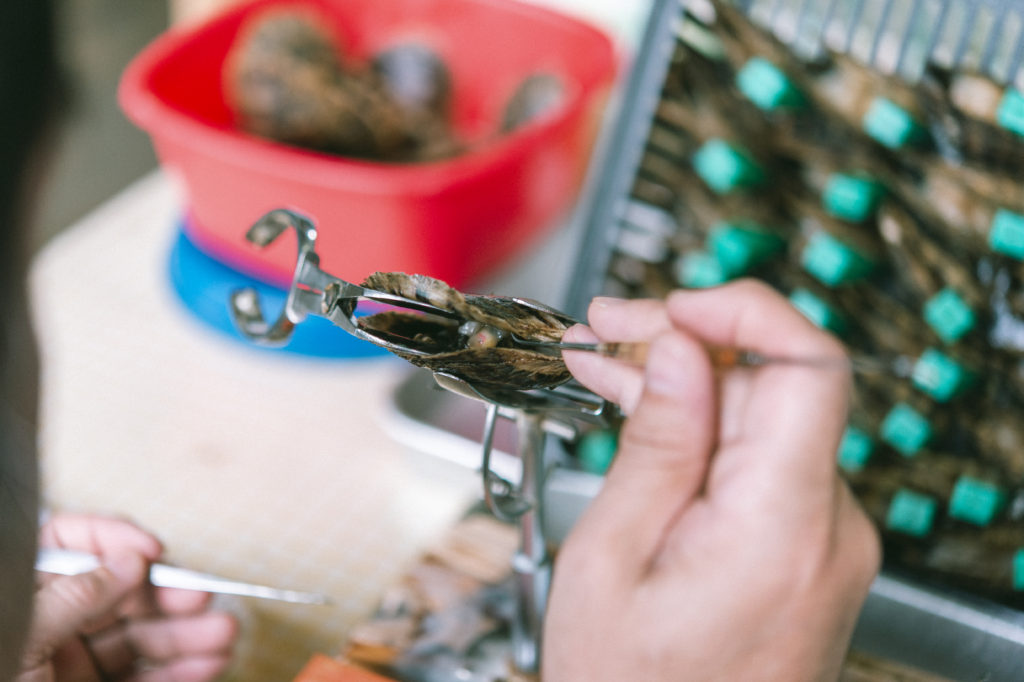

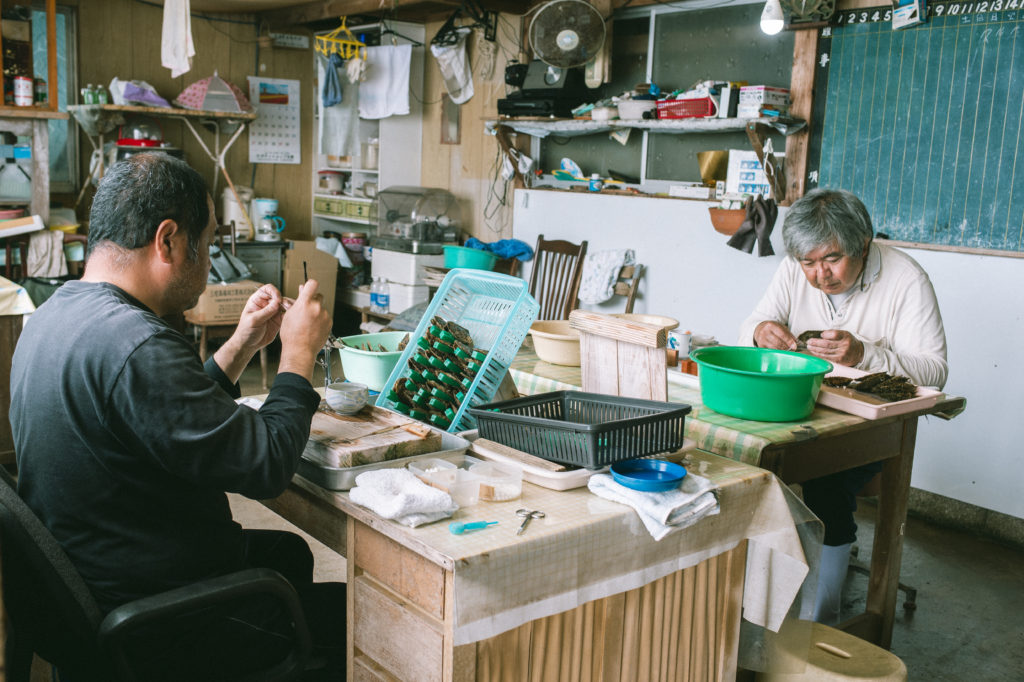
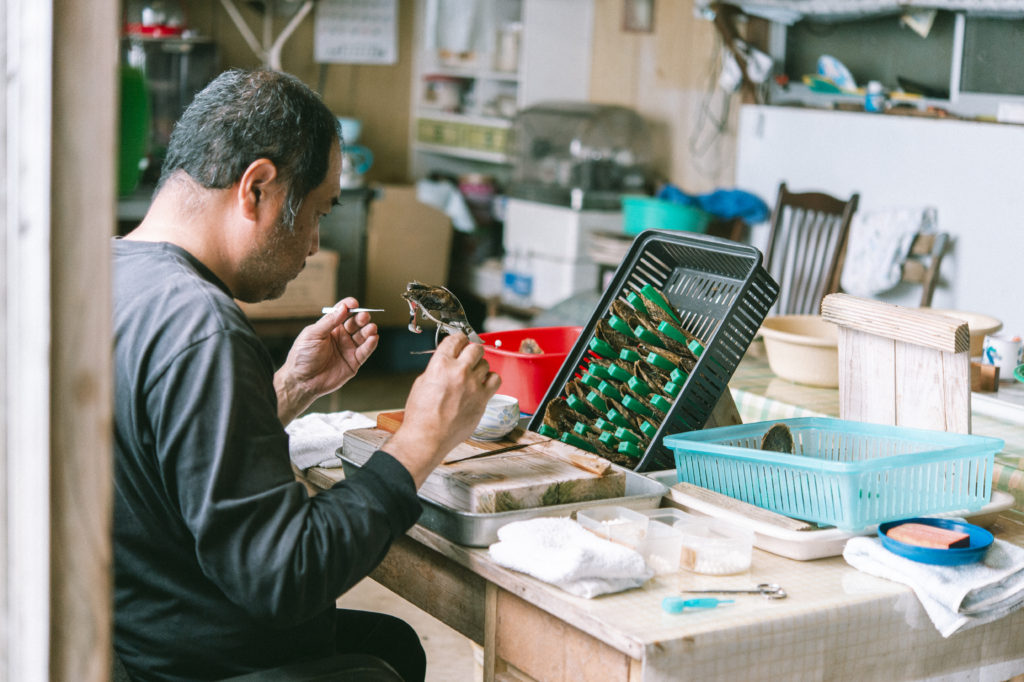
->挿核手術、珠入れ
①ピース貝、内側の色が美しい真珠質分泌の盛んなあこや貝からその細胞を2mm角に切り取ります。
②このピースと核を母貝の子宮に入れていきます。この作業は、高度な技術と経験が必要です。真剣な趣で一個、一個、ピースと核を入れ続けます。
この作業をひたすら行います。珠入れシーズンはだいたい9月くらいまで。
何万個という母貝の子宮にピースと核を入れて行きます。
何万個という母貝の子宮にピースと核を入れて行きます。
-> How to do the surgery? (inserting nuclear into mother oyster)
1. We cut cells, known as “Piece”, from the “Piece Oysters”, that have the beauty of the mother of pearl in its inner surface. Each “Piece” should be cut into a smaller size of 2mm.
2. Inserting the “Piece” and nuclear into the womb of the mother oyster. This surgery requires a high level of skills, experiences, and concentration.
2. Inserting the “Piece” and nuclear into the womb of the mother oyster. This surgery requires a high level of skills, experiences, and concentration.
Farmers seriously put the Piece and nuclear into its womb one at a time.
This is a long and sensitive process. They need to concentrate a lot to ensure its correct position. If it’s inserted incorrectly, a pearl won’t be born.
This is a long and sensitive process. They need to concentrate a lot to ensure its correct position. If it’s inserted incorrectly, a pearl won’t be born.
They have to do this process repeatedly with about 10,000 Akoya Oysters.
The Tama-Ire season (surgery season) usually starts in the middle of May until the end of September.
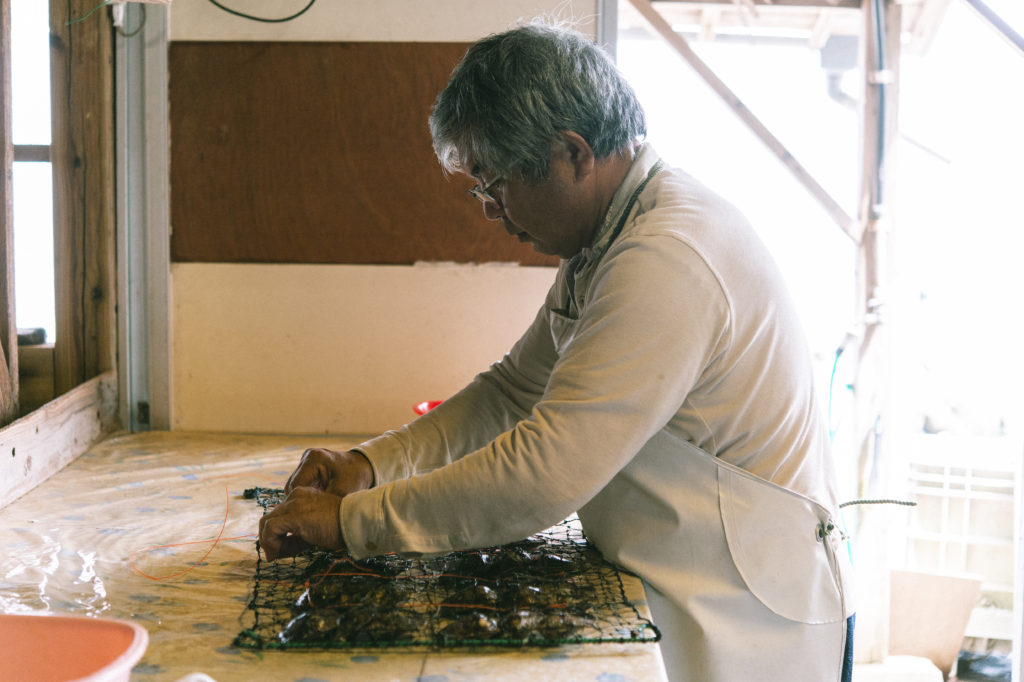
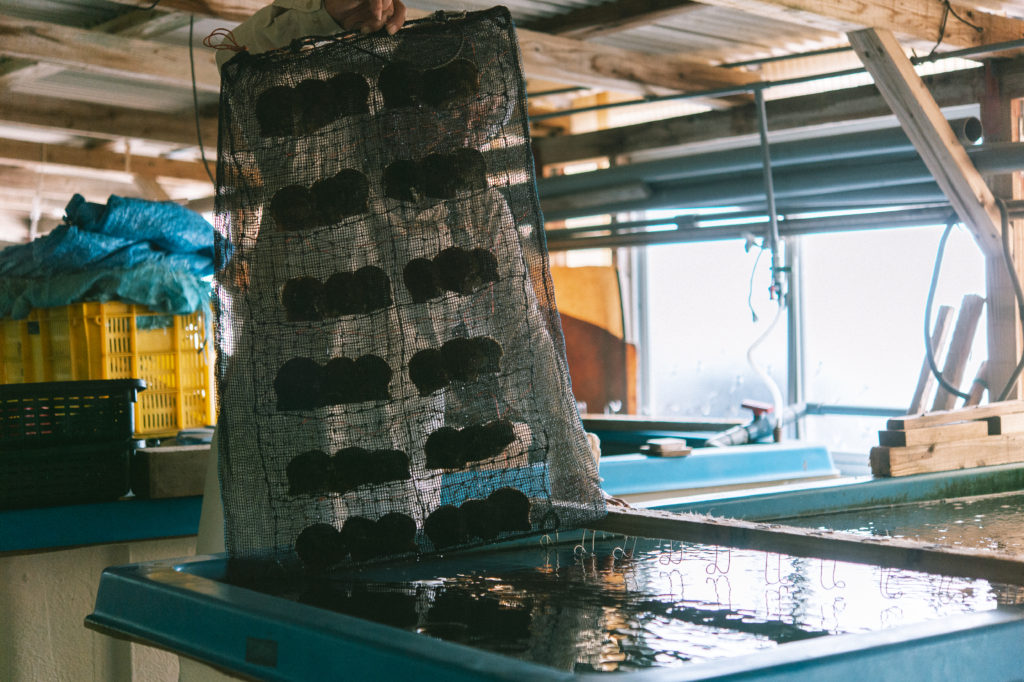
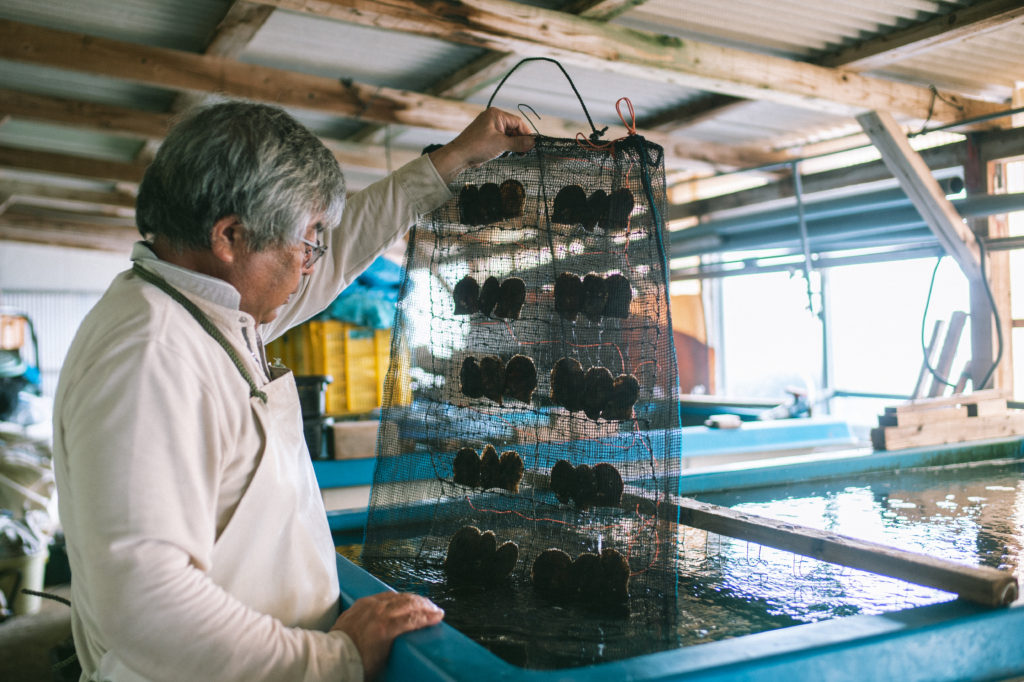
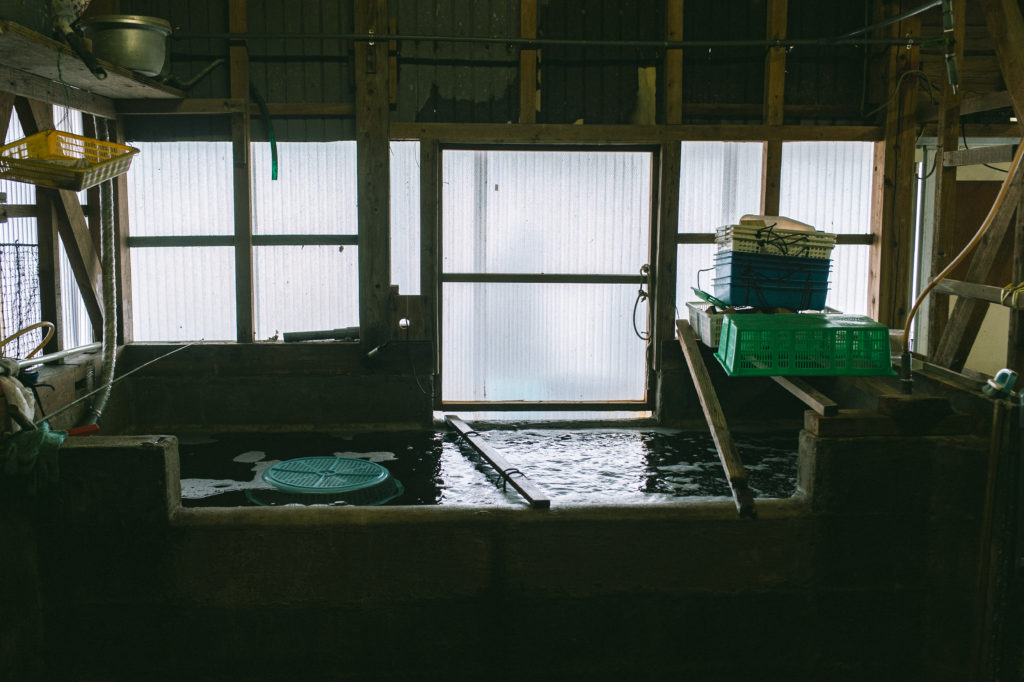
Ⅲ.
養生
その後、手術をして体を痛めているのと同じ状態ですので、しばらく、10−20日間養生します。その後、体力が回復し、体内で真珠層を作り(育て)うつくしい真珠を作るように外の海の真珠イカダに吊します。これが、9月ー6月に行われる珠入れ、と呼ばれる挿核手術の一連の流れです。
III.
Curing term
“Tama-Ire” (surgery) is like a human surgery. Akoya mother oysters need to take a rest to recover their body for 10-20 days in the calm sea. After their recovery period, they’ll be hung on the floating grillage. Mother Akoya oysters start to create pearls in their womb there.
These are the process of “Tama-ire”.
“Tama-Ire” (surgery) is like a human surgery. Akoya mother oysters need to take a rest to recover their body for 10-20 days in the calm sea. After their recovery period, they’ll be hung on the floating grillage. Mother Akoya oysters start to create pearls in their womb there.
These are the process of “Tama-ire”.
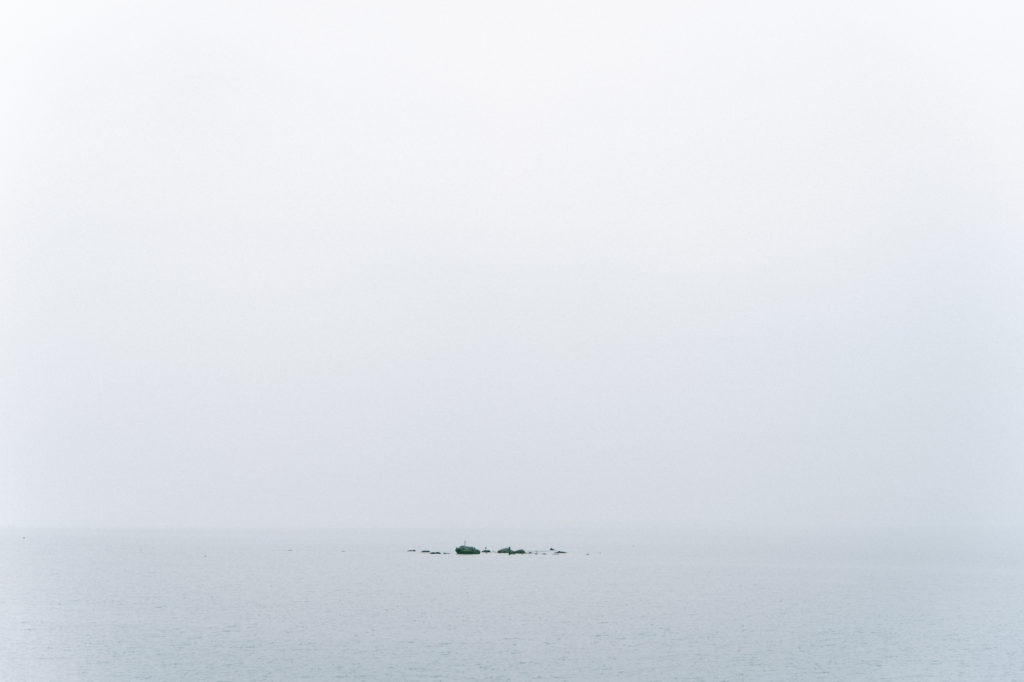
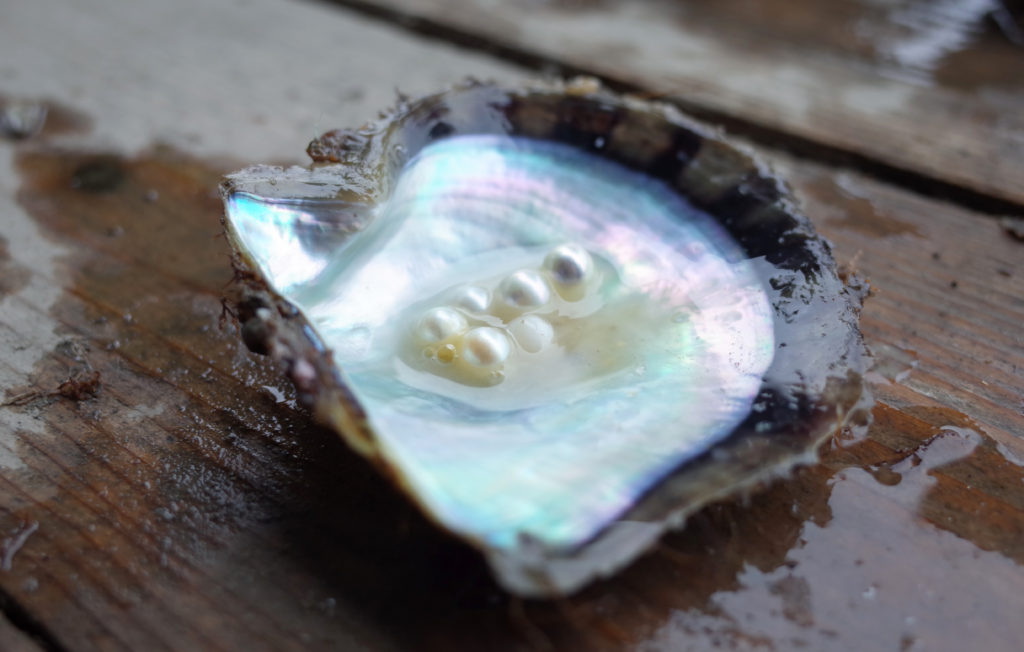
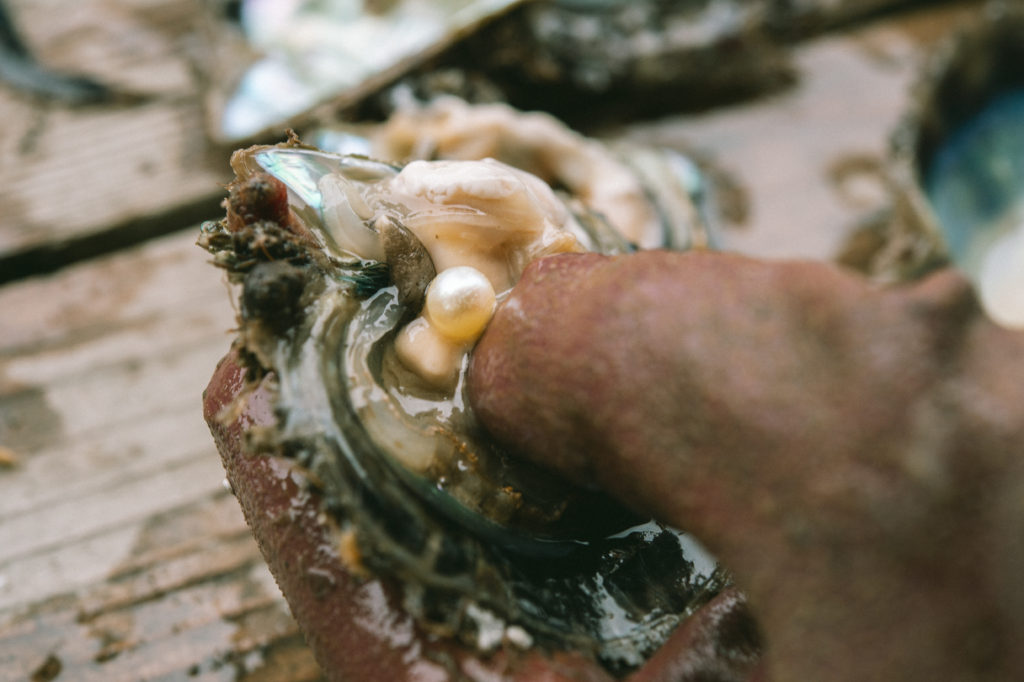
-> 珠入れを見ておもったこと
珠入れを初めて見た時それが人間の手術と少しもかわりなく、生命として同じだと感じた。
珠入れを初めて見た時それが人間の手術と少しもかわりなく、生命として同じだと感じた。
その珠入れと呼ぶ ’手術’ はあこや貝に痛いだろうなとも感じた。
さらに、美しい珠を作るために2個のあこや貝が命を捧げるとはと驚いた。
これらが最初にあこや真珠の珠入れを見た時の驚きだった。
また、丸くて白い珠が真珠だとそれまで思っていたけれど、
そうではなく、人間と同じ生物なので、その個性は様々で突起があったり、黄色味、青みがかった色のものなど、同じ真珠というものは二つとない、ユニークなものだと知った。
そしてなにより母貝から生まれたばかりのそのままの真珠は生命そのもので、その美しさに驚いた。何もしらなかったわたしはあこや真珠に申し訳ないと思った。
私にはあこや真珠は命そのものだと思う。あこや貝が一生懸命に育てた命。
だとしたら、そのままのあこや真珠の美しさを尊重したい、大事にしたい。そして神話の時代、この大和では”たま” は神だった、真珠は ”しらたま” だ。アニミズムの生きる場所。(ここら辺の話は興味深く長くなるのでまた別にお話しします。)
日本のあこや真珠が美しいと言われる所以は日本の四季にある。四季によって影響を受ける海の環境で美しいあこや真珠が育つのだ。つまりあこや真珠の美しさはその海そのものだといってもいい。
あこや真珠養殖は、珠入れのスキルや方法、育て方などで異なる珠ができるけれど、半分以上はその海のコンディションに頼っている。海に抱かれてあこや真珠は成長する。そして養殖の方々の真珠への思い。松田さんには海や真珠に対しての愛を感じる。うつくしいあこや真珠は海(自然)と人間のマリアージュでもあるのだ。
そして、九州、海に囲まれた島。
あこや真珠は黒潮にのって何万年も前にここに最初にたどり着いた。海だけがまだ狩猟採集も含め原始的風景を残している、母なる海だ。
あこや真珠は黒潮にのって何万年も前にここに最初にたどり着いた。海だけがまだ狩猟採集も含め原始的風景を残している、母なる海だ。
目の前にあるこの海をもう少し気にしたい、たくさんの豊かさが眠っている。
-> My impressions about the process of “Tama-Ire “
When I saw Tama-Ire (surgery) for the first time, I didn’t feel any difference with human surgery. I felt that Akoya oysters are almost the same creatures as humans.
It seems that Tama-Ire was also painful for Akoya oysters. In addition, I was surprised that two oysters have to sacrifice themselves to give birth to a beautiful pearl.
These were my first impressions when I saw Tama-ire for the first time.
It seems that Tama-Ire was also painful for Akoya oysters. In addition, I was surprised that two oysters have to sacrifice themselves to give birth to a beautiful pearl.
These were my first impressions when I saw Tama-ire for the first time.
I thought that all pearls have the same color (white) and shape (sphere),
but pearls have the same diversity as humans have.
They have unique physical traits such as shapes, color variation, etc. Some pearls have nub and not a perfect sphere. Some are yellowish, bluish, or pinkish in color.
Therefore, I realized that there are no two pearls that are exactly alike. All pearls are unique.
When I saw a pearl that just came out, I was mesmerized by its beauty of life.
I felt embarrassed by how little my knowledge about pearls during that time.
but pearls have the same diversity as humans have.
They have unique physical traits such as shapes, color variation, etc. Some pearls have nub and not a perfect sphere. Some are yellowish, bluish, or pinkish in color.
Therefore, I realized that there are no two pearls that are exactly alike. All pearls are unique.
When I saw a pearl that just came out, I was mesmerized by its beauty of life.
I felt embarrassed by how little my knowledge about pearls during that time.
For me, Pearl has a life of itself. The Akoya oyster took care of the pearl with so much love in it’s womb. So, I would like to respect their natural beauty and accept them for what they are.
A long time ago, Pearl was called “Shira-tama”. “Tama” means God in Japan.
Pearl was considered sacred in the mythology era. Animism was also vivid in that era.
This will be another long yet interesting story, so I’ll try to talk about it next time.
A long time ago, Pearl was called “Shira-tama”. “Tama” means God in Japan.
Pearl was considered sacred in the mythology era. Animism was also vivid in that era.
This will be another long yet interesting story, so I’ll try to talk about it next time.
It is said that the Akoya Pearl from Japan is the most beautiful in the world,
because of its four seasons. The sea is affected by the four seasons. This makes a good environment for our precious pearls to grow beautifully. I could say that its beauty of acoya pearl is made from the sea environment . The pearls are as lovely as the sea itself.
because of its four seasons. The sea is affected by the four seasons. This makes a good environment for our precious pearls to grow beautifully. I could say that its beauty of acoya pearl is made from the sea environment . The pearls are as lovely as the sea itself.
The different types of Akoya Pearls are produced through the combination of the critical process of Tama-Ire, the high level of skills of the farmers, the careful handling of Akoya Oysters, and other processes involved in the cultivation of Akoya Pearls.
However, the sea condition plays a major role in how the Akoya pearls grow up. They have a deep connection that affects the pearl’s growth. If the sea will embrace the Akoya pearls with its breathtaking beauty, there’s no doubt that the pearls will also be mesmerizing.In addition, lots of passion of the farmers contributed to the growth of these beautiful pearls. I can feel the overflowing love of Mr. Matsuda for the Sea, Akoya Oysters, and Akoya Pearls.
So, I can say that this cultivation akoya pearl is like the marriage between the sea ( nature) and humans.
Kyushu region, consisted of the islands surrounded by the sea, and a home to Akoya Oysters.
Akoya Oysters have arrived here through the Black current in ancient times.
A lot of primitive things we can do with the Mother Sea, such as hunting and gathering sea creatures. Then its land scape still has remained over a long period of time.
We have to take care of our Mother Sea in front of us to preserve its beauty and richness.
A lot of primitive things we can do with the Mother Sea, such as hunting and gathering sea creatures. Then its land scape still has remained over a long period of time.
We have to take care of our Mother Sea in front of us to preserve its beauty and richness.